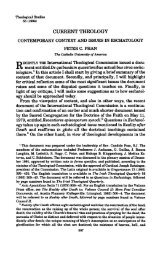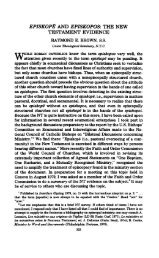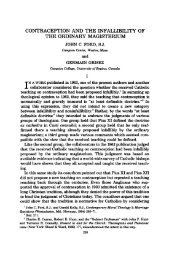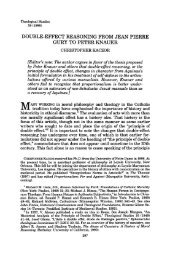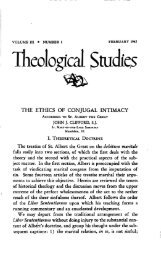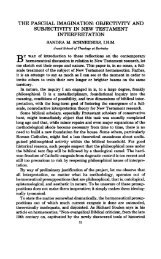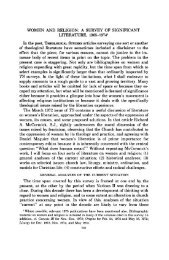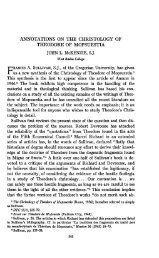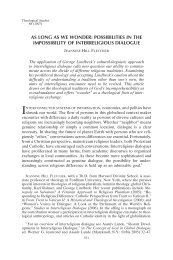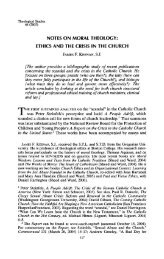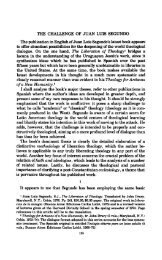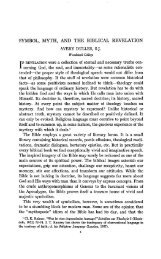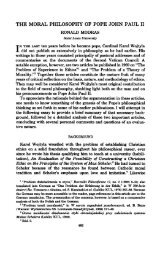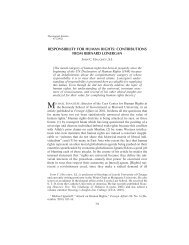THE HOLINESS and utter transcendence of God over all of creation ...
THE HOLINESS and utter transcendence of God over all of creation ...
THE HOLINESS and utter transcendence of God over all of creation ...
You also want an ePaper? Increase the reach of your titles
YUMPU automatically turns print PDFs into web optimized ePapers that Google loves.
Theological Studies<br />
45 (1984)<br />
<strong>THE</strong> INCOMPREHENSIBILITY OF GOD<br />
AND <strong>THE</strong> IMAGE OF GOD MALE AND FEMALE<br />
ELIZABETH A JOHNSON, C.S.J.<br />
The Catholic University <strong>of</strong> America<br />
<strong>THE</strong> <strong>HOLINESS</strong> <strong>and</strong> <strong>utter</strong> <strong>transcendence</strong> <strong>of</strong> <strong>God</strong> <strong>over</strong> <strong>all</strong> <strong>of</strong> <strong>creation</strong> has<br />
always been an absolutely central affirmation <strong>of</strong> the Judeo-Christian<br />
tradition. <strong>God</strong> as <strong>God</strong>—source, redeemer, <strong>and</strong> goal <strong>of</strong> <strong>all</strong>—is illimitable<br />
mystery who, while immanently present, cannot be measured or controlled.<br />
The doctrine <strong>of</strong> divine incomprehensibility is a corollary <strong>of</strong> this<br />
divine <strong>transcendence</strong>. In essence, <strong>God</strong>'s unlikeness to the corporal <strong>and</strong><br />
spiritual finite world is total; hence we simply cannot underst<strong>and</strong> <strong>God</strong>.<br />
No human concept, word, or image, <strong>all</strong> <strong>of</strong> which originate in experience<br />
<strong>of</strong> created reality, can circumscribe the divine reality, nor can any human<br />
construct express with any measure <strong>of</strong> adequacy the mystery <strong>of</strong> <strong>God</strong>, who<br />
is ineffable. This situation is due not to some reluctance on the part <strong>of</strong><br />
<strong>God</strong> to self-reveal in a full way, nor to the sinful condition <strong>of</strong> the human<br />
race making reception <strong>of</strong> such a revelation impossible, nor even to our<br />
contemporary mentality <strong>of</strong> skepticism in religious matters. Rather, it is<br />
proper to <strong>God</strong> as <strong>God</strong> to transcend <strong>all</strong> direct similarity to creatures, <strong>and</strong><br />
thus never to be known comprehensively or essenti<strong>all</strong>y as <strong>God</strong>. In<br />
Augustine's unforgettable echo <strong>of</strong> the insight <strong>of</strong> earlier Greek theologians,<br />
if we have comprehended, then what we have comprehended is not <strong>God</strong>.<br />
This sense <strong>of</strong> an unfathomable depth <strong>of</strong> mystery, <strong>of</strong> a vastness <strong>of</strong> <strong>God</strong>'s<br />
glory too great for the human mind to grasp, undergirds the religious<br />
significance <strong>of</strong> speech about <strong>God</strong>; such speech never definitively possesses<br />
its subject but leads us ever more pr<strong>of</strong>oundly into attitudes <strong>of</strong> awe <strong>and</strong><br />
adoration. 1<br />
It would be a serious mistake to think that <strong>God</strong>'s self-revelation<br />
through powerful acts <strong>and</strong> inspired words in the Jewish tradition <strong>and</strong><br />
through the history <strong>and</strong> destiny <strong>of</strong> Jesus Christ which give rise to the<br />
Christian tradition removes the ultimate unknowability <strong>of</strong> <strong>God</strong>. In the<br />
history <strong>of</strong> these traditions, revelation has in fact given rise to the<br />
"dangerous situation" in which the need to preach <strong>and</strong> interpret has<br />
resulted in words becoming too clear <strong>and</strong> ideas too distinct, almost as if<br />
1 See developments <strong>of</strong> the theme <strong>of</strong> divine incomprehensibility in Victor White, <strong>God</strong> the<br />
Unknown (New York: Harper, 1956); Charles Bent, Interpreting the Doctrine <strong>of</strong> <strong>God</strong> (New<br />
York: Paulist, 1968); Gordon Kaufman, <strong>God</strong> the Problem (Cambridge, Mass.: Harvard<br />
University, 1972), esp. "<strong>God</strong> as Symbol" 82-115.<br />
441
442 <strong>THE</strong>OLOGICAL STUDIES<br />
they were direct transcripts <strong>of</strong> divine reality. 2 At times we have forgotten<br />
whom we are dealing with, <strong>and</strong> have created the impression that the<br />
unknown <strong>God</strong> is now available for inspection, caught within our narratives<br />
or metaphysical concepts. Revelation, however, cannot <strong>and</strong> does<br />
not dissolve the mystery <strong>of</strong> <strong>God</strong>; in its light we see ever more clearly the<br />
incomprehensibility <strong>of</strong> <strong>God</strong> as free <strong>and</strong> liberating love, love which chooses<br />
us without our deserving it, bears <strong>and</strong> removes our bondage, gathers us<br />
in. Even <strong>and</strong> especi<strong>all</strong>y in revelation <strong>God</strong> remains the wholly other,<br />
conceptu<strong>all</strong>y inapprehensible, <strong>and</strong> so <strong>God</strong>.<br />
The contemporary ch<strong>all</strong>enge <strong>of</strong> atheism <strong>and</strong> the purification <strong>of</strong> the<br />
doctrine <strong>of</strong> <strong>God</strong> which meeting it entails has led theology in some measure<br />
to a new reappropriation <strong>of</strong> the insight <strong>of</strong> the best <strong>of</strong> the theological<br />
tradition that it is impossible to underst<strong>and</strong> <strong>God</strong>. Now another ch<strong>all</strong>enge,<br />
from the perspective <strong>of</strong> believing women, holds the promise <strong>of</strong> deepening<br />
yet further this truth <strong>of</strong> the incomprehensibility <strong>of</strong> <strong>God</strong>, as well as<br />
promoting the human dignity <strong>of</strong> women—the two not being separable<br />
from one another.<br />
The problem with the underst<strong>and</strong>ing <strong>of</strong> <strong>God</strong> which women theologians,<br />
out <strong>of</strong> personal experience <strong>of</strong> its debilitating effects, have identified is<br />
that it envisions <strong>God</strong> exclusively through analogy with the male human<br />
being, <strong>and</strong> does so with a pervasiveness <strong>and</strong> tenacity which at least raises<br />
the question <strong>of</strong> the success <strong>of</strong> the first comm<strong>and</strong>ment in eliciting obedience.<br />
Imagery for the divine throughout the Judeo-Christian tradition is<br />
taken predominantly from the roles <strong>and</strong> relations <strong>of</strong> men, <strong>God</strong> being<br />
named as lord, king, father, son. Likewise, male self-definition has shaped<br />
the metaphysical concept <strong>of</strong> <strong>God</strong> which developed from the encounter <strong>of</strong><br />
biblical with Greek philosophical traditions. The latter had equated male<br />
reality with spirit, with mind <strong>and</strong> reason, <strong>and</strong>, most importantly, with<br />
act, reserving for female reality a contrasting intrinsic connection with<br />
matter, with body <strong>and</strong> instinct, <strong>and</strong> with potency. <strong>God</strong> as absolute being<br />
or pure act necessarily excluded <strong>all</strong> potency, passivity, <strong>and</strong> prime matter,<br />
<strong>and</strong> thus could be thought only in analogy with the human spiritu<strong>all</strong>y<br />
masculine to the exclusion <strong>of</strong> analogy with the feminine passive material<br />
principle. This assumption <strong>and</strong> its attendant <strong>and</strong>rocentric presuppositions<br />
permeate the classical Christian philosophical doctrine <strong>of</strong> <strong>God</strong> as<br />
2 Hans Urs von Balthasar, "The Unknown <strong>God</strong>," The von Balthasar Reader, ed. M. Kehl<br />
<strong>and</strong> W. Löser (New York: Crossroad, 1982) 184. Balthasar queries where one can find a<br />
work <strong>of</strong> dogmatics which gives the incomprehensibility <strong>of</strong> <strong>God</strong> significant expression;<br />
theological textbooks have forgotten it; even Barth does not hold on to it to the end.<br />
Research for this study has convinced me that he is right; material on incomprehensibility<br />
is not plentiful. For the relation <strong>of</strong> <strong>God</strong>'s incomprehensibility to revelation, see also William<br />
Hill, Knowing the Unknown <strong>God</strong> (New York: Philosophical Library, 1971) ii; Leo Scheffczyk,<br />
"<strong>God</strong>," Sacramentum mundi 2 (New York: Herder & Herder, 1968) 382-87.
INCOMPREHENSIBILITY OF GOD 443<br />
well as the specific<strong>all</strong>y Christian doctrine <strong>of</strong> the Trinity. 3 In a strikingly<br />
honest discussion <strong>of</strong> the issue, John B. Cobb summarizes: "Historic<strong>all</strong>y,<br />
whatever <strong>God</strong>'s true nature <strong>and</strong> identity may be, <strong>God</strong> has been experienced,<br />
conceived, <strong>and</strong> spoken <strong>of</strong> as masculine," <strong>and</strong> this is a statement<br />
as applicable to metaphysical thinking about <strong>God</strong> as it is to religious<br />
images. 4<br />
The critique brought by women theologians against the exclusive<br />
centrality <strong>of</strong> the male image <strong>and</strong> idea <strong>of</strong> <strong>God</strong> is not only that in stereotyping<br />
<strong>and</strong> then banning female reality as suitable reference points for<br />
<strong>God</strong>, <strong>and</strong>rocentric thought has denigrated the human dignity <strong>of</strong> women.<br />
The critique also bears directly on the religious significance <strong>and</strong> ultimate<br />
truth <strong>of</strong> <strong>and</strong>rocentric thought about <strong>God</strong>. The charge, quite simply, is<br />
that <strong>of</strong> idolatry. 5 Normative conceptualization <strong>of</strong> <strong>God</strong> in analogy with<br />
male reality alone is the equivalent <strong>of</strong> the graven image, a finite representation<br />
being taken for <strong>and</strong> worshiped as the whole. What is violated<br />
is both the creature's limitation <strong>and</strong> the unknowable <strong>transcendence</strong> <strong>of</strong><br />
the true <strong>God</strong>. It is true that sophisticated thinkers will immediately deny<br />
that any maleness in image or concept <strong>of</strong> <strong>God</strong> is meant to be taken<br />
liter<strong>all</strong>y. Yet the association <strong>of</strong> <strong>God</strong> with maleness lingers on implicitly<br />
even in highly abstract discussions, as evidenced in statements such as<br />
"<strong>God</strong> is not male; He is Spirit." Such an association is also presumed to<br />
be normative, a point demonstrated empiric<strong>all</strong>y by the dismay <strong>of</strong>ten<br />
registered when <strong>and</strong> if <strong>God</strong> is referred to with feminine images or<br />
pronouns. If it is not meant that <strong>God</strong> is male when masculine imagery is<br />
used, why the objection when female images are used? But in fact an<br />
intrinsic connection between <strong>God</strong> <strong>and</strong> maleness is usu<strong>all</strong>y intended,<br />
however implicitly. In spite <strong>of</strong> the affirmation <strong>of</strong> divine <strong>transcendence</strong>,<br />
the predominant developments <strong>of</strong> the Judeo-Christian tradition have<br />
3 See development <strong>of</strong> this thesis with focus on Augustine <strong>and</strong> Aquinas by Franz Mayr,<br />
"Patriarchalisches Gottesverständnis?" Theologische Quartalschrift 152 (1972) 224-55, <strong>and</strong><br />
"Trinitätstheologie und theologische Anthropologie," Zeitschrift für Theologie und Kirche<br />
68 (1971) 427-77; also Rosemary Radford Ruether, "Misogynism <strong>and</strong> Virginal Feminism,"<br />
Religion <strong>and</strong> Sexism, ed. R. Ruether (New York: Simon <strong>and</strong> Schuster, 1974) 150-83.<br />
4 John B. Cobb, "<strong>God</strong> <strong>and</strong> Feminism," Talking about <strong>God</strong>, ed. J. B. Cobb <strong>and</strong> David<br />
Tracy (New York: Seabury, 1983) 79.<br />
5 For expatiations on the charge <strong>of</strong> idolatry, from which the following section draws, see<br />
Rosemary Radford Ruether, Sexism <strong>and</strong> <strong>God</strong>-Talk Toward a Feminist Theology (Boston:<br />
Beacon, 1983) 22-27; also her "The Female Nature <strong>of</strong> <strong>God</strong>," <strong>God</strong> as Father? (Concilium 143;<br />
New York: Seabury, 1981) 66; Mary Daly, Beyond <strong>God</strong> the Father (Boston: Beacon, 1973);<br />
Elisabeth Schüssler Fiorenza, "Feminist Spirituality, Christian Identity, <strong>and</strong> Catholic<br />
Vision," Womanspirit Rising, ed. C. Christ <strong>and</strong> J. Plaskow (San Francisco: Harper & Row,<br />
1979) 139; Rita Gross, "Female <strong>God</strong> Language in a Jewish Context," ibid. 169-70; Anne<br />
Carr, "Is a Christian Feminist Theology Possible?" TS 43 (1982) 296; Gail Ramshaw<br />
Schmidt, "De divinis nominibus: The Gender <strong>of</strong> <strong>God</strong>," Worship 56 (1982) 117-31.
444 <strong>THE</strong>OLOGICAL STUDIES<br />
lifted up the male way <strong>of</strong> being human to functional equivalence with<br />
the divine. More solid than stone, more resistant to iconoclasm than<br />
bronze, seems to be the male substratum <strong>of</strong> the idea <strong>of</strong> <strong>God</strong> cast in<br />
theological language <strong>and</strong> engraved in public <strong>and</strong> private prayer. Thus the<br />
critique: "It is idolatrous to make males more 'like <strong>God</strong>* than females. It<br />
is blasphemous to use the image <strong>and</strong> name <strong>of</strong> the Holy to justify<br />
patriarchal domination The image <strong>of</strong> <strong>God</strong> as predominantly male is<br />
fundament<strong>all</strong>y idolatrous" (as would be the image <strong>of</strong> <strong>God</strong> as exclusively<br />
female). 6<br />
Those who do not ab<strong>and</strong>on the tradition because <strong>of</strong> its pervasive<br />
<strong>and</strong>rocentrism but wrestle with it for its own deeper liberating truth<br />
propose by contrast an underst<strong>and</strong>ing <strong>of</strong> the unknown <strong>God</strong> derived from<br />
analogy with both male <strong>and</strong> female reality. The biblical <strong>creation</strong> narrative<br />
which presents both male <strong>and</strong> female created in the image <strong>of</strong> <strong>God</strong> (Gen<br />
1:26-27), <strong>and</strong> the early Christian baptismal hymn which sees that in the<br />
world re-created by <strong>God</strong>'s redeeming love there is no more division by<br />
race, class, or sex but <strong>all</strong> are one in Christ Jesus (Gal 3:28), are taken as<br />
clues that male <strong>and</strong> female are identical in their capacity to be images <strong>of</strong><br />
<strong>God</strong>. Hence <strong>God</strong>, who is beyond <strong>all</strong> imaging, is well presented by analogy<br />
with both, <strong>and</strong> not well conceived on the pattern <strong>of</strong> merely one. The very<br />
incomprehensibility <strong>of</strong> <strong>God</strong> dem<strong>and</strong>s a proliferation <strong>of</strong> images <strong>and</strong> a<br />
variety <strong>of</strong> names, each <strong>of</strong> which acts as a corrective against the tendency<br />
<strong>of</strong> any one to become reified <strong>and</strong> literal. Female images <strong>and</strong> concepts <strong>of</strong><br />
<strong>God</strong> disclose the relative character <strong>of</strong> male images <strong>and</strong> bracingly restrict<br />
their claim to ultimacy. Use <strong>of</strong> "<strong>God</strong>-She" immediately indicates the<br />
inherent inadequacy <strong>of</strong> "<strong>God</strong>-He." The underst<strong>and</strong>ing that <strong>God</strong> lies<br />
beyond whatever is thought or said is realized in the use <strong>of</strong> diverse images<br />
which balance or negate each other <strong>and</strong> thus point pr<strong>of</strong>oundly to the<br />
mystery <strong>of</strong> the present <strong>God</strong> who remains unknown.<br />
In my judgment, what is at stake in this issue is simultaneously the<br />
freeing <strong>of</strong> both women <strong>and</strong> men from constricting reality models <strong>and</strong><br />
social roles, <strong>and</strong> the very viability <strong>of</strong> the Judeo-Christian tradition for<br />
present <strong>and</strong> coming generations. The ch<strong>all</strong>enge to male monotheism <strong>and</strong>/<br />
or male Trinitarian thought arising from new recognition <strong>of</strong> women's<br />
equality <strong>and</strong> human dignity is one <strong>of</strong> the strongest in the course <strong>of</strong> the<br />
Judeo-Christian tradition, presaging a real Copernican revolution. As<br />
Wolfhart Pannenberg has elucidated the dynamics <strong>of</strong> the history <strong>of</strong><br />
religions, religions die when their lights fail, when they lose the power to<br />
interpret the full range <strong>of</strong> present experience in the light <strong>of</strong> their idea <strong>of</strong><br />
<strong>God</strong>. 7 If <strong>God</strong> is worshiped as the <strong>all</strong>-determining reality, the power <strong>over</strong><br />
6 Ruether, Sexism <strong>and</strong> <strong>God</strong>-Talk 23.<br />
7 Wolf hart Pannenberg, "Toward a Theology <strong>of</strong> the History <strong>of</strong> Religions," Basic Questions<br />
in Theology 2 (Philadelphia: Fortress, 1971) 65-118; also his "Anthropology <strong>and</strong> the
INCOMPREHENSIBILITY OF GOD 445<br />
<strong>all</strong>, then the truth <strong>of</strong> <strong>God</strong> is tested by the extent to which the idea <strong>of</strong><br />
<strong>God</strong> takes account <strong>of</strong> currently accessible aspects <strong>of</strong> reality <strong>and</strong> by the<br />
ability <strong>of</strong> the idea <strong>of</strong> <strong>God</strong> to integrate the complexity <strong>of</strong> present experience<br />
into itself. If the idea <strong>of</strong> <strong>God</strong> does not keep pace with developing reality,<br />
the power <strong>of</strong> experience pulls people on <strong>and</strong> the god dies, fading from<br />
memory. Is the <strong>God</strong> <strong>of</strong> the Judeo-Christian tradition so true as to be able<br />
to take account <strong>of</strong>, illumine, <strong>and</strong> integrate the currently accessible<br />
experience <strong>of</strong> women? This is an absolutely critical question.<br />
On the strength <strong>of</strong> the assumption that the incomprehensible mystery<br />
<strong>of</strong> <strong>God</strong> <strong>and</strong> the image <strong>of</strong> <strong>God</strong> male <strong>and</strong> female mutu<strong>all</strong>y support each<br />
other, this study intends to re-examine <strong>and</strong> correlate the tradition regarding<br />
both. Such an exploration serves to highlight one <strong>of</strong> the sources<br />
for the renewal <strong>of</strong> the idea <strong>of</strong> <strong>God</strong> within the tradition itself, <strong>and</strong> makes<br />
room for underst<strong>and</strong>ing female conceptualizations <strong>of</strong> <strong>God</strong> as not only<br />
legitimate but also necessary. Subsequently, with that assumption at<br />
least on the way to being established, three contemporary approaches to<br />
the renewal <strong>of</strong> the idea <strong>of</strong> <strong>God</strong> relative to women are examined, two <strong>of</strong><br />
which, while possibly helpful for a time, are judged to be ultimately<br />
deficient. In the end we are left with a task yet to be done, the conceptualization<br />
<strong>of</strong> a <strong>God</strong> than which nothing greater can be conceived, a <strong>God</strong><br />
worthy <strong>of</strong> the worship <strong>of</strong> <strong>all</strong>.<br />
INCOMPREHENSIBILITY AND FEMALE IMAGING OF GOD<br />
Biblical<br />
The Scriptures contain no systematic development <strong>of</strong> the theme <strong>of</strong><br />
<strong>God</strong>'s unknowability but disclose awareness <strong>of</strong> this through repeated<br />
stress on <strong>God</strong>'s holiness, transcendent otherness, <strong>and</strong> freedom <strong>of</strong> action<br />
in history. At the head <strong>of</strong> the list <strong>of</strong> comm<strong>and</strong>ments, <strong>God</strong>'s otherness<br />
comes to expression in the ban on the making <strong>and</strong> adoring <strong>of</strong> images<br />
(Exod 20:2-5):<br />
I am the Lord your <strong>God</strong> who brought you out <strong>of</strong> the l<strong>and</strong> <strong>of</strong> Egypt, out <strong>of</strong> the<br />
house <strong>of</strong> bondage. You sh<strong>all</strong> have no other gods before me. You sh<strong>all</strong> not make<br />
for yourself a graven image, or any likeness <strong>of</strong> anything that is in heaven above,<br />
or that is in the earth beneath, or that is in the water under the earth; you sh<strong>all</strong><br />
not bow down to them or serve them; for I the Lord your <strong>God</strong> am a jealous<br />
<strong>God</strong>... . 8<br />
Question <strong>of</strong> <strong>God</strong>," The Idea <strong>of</strong> <strong>God</strong> <strong>and</strong> Human Freedom (Philadelphia: Westminster, 1973)<br />
94-98; <strong>and</strong> his Theology <strong>and</strong> the Philosophy <strong>of</strong> Science (Philadelphia: Westminster, 1976)<br />
301-26.<br />
8 All biblical quotations are from the Revised St<strong>and</strong>ard Version (New York: Oxford<br />
University, 1965).
446 <strong>THE</strong>OLOGICAL STUDIES<br />
In view <strong>of</strong> the fact that despite the ban images <strong>of</strong> <strong>God</strong> at least in a verbal<br />
sense abound throughout the Scriptures, the intent <strong>of</strong> these comm<strong>and</strong>s<br />
would seem to be that <strong>of</strong> preventing both polytheism <strong>and</strong> magic, while<br />
insuring that any image used <strong>of</strong> the holy <strong>and</strong> free <strong>God</strong> remains cognizant<br />
<strong>of</strong> its own limitation. 9 There is but one <strong>God</strong>, comparable to no other<br />
individual or corporate created reality.<br />
Abundant references throughout the Torah <strong>and</strong> the prophetic <strong>and</strong><br />
wisdom traditions spell out the implications <strong>of</strong> this insight. The holy<br />
name YHWH, signifying divine presence but not essence, is unfathomable<br />
(Exod 3:14). Even in the making <strong>of</strong> the covenant no one sees <strong>God</strong>'s<br />
form (Deut 4:12, 15-16). <strong>God</strong> is a hidden <strong>God</strong>, impossible to compare<br />
with anything or anyone else (Isa 40:18, 25; 45:15). <strong>God</strong> the Holy One is<br />
<strong>God</strong> <strong>and</strong> not man (sic, Num 23:19; Hos 11:9). <strong>God</strong> is great, beyond what<br />
we can ever fathom (Job 36:26). The idea <strong>of</strong> divine incomprehensibility<br />
is not watered down with the advent <strong>of</strong> <strong>God</strong> in Jesus Christ. Rather, the<br />
mystery <strong>of</strong> the covenanting <strong>God</strong> remains the horizon within which early<br />
Christian believers interpret the life, death, <strong>and</strong> resurrection <strong>of</strong> Jesus<br />
Christ. The <strong>God</strong> who raised Jesus from the dead cannot be captured in<br />
silver, gold, stone, or any representation <strong>of</strong> human imagination (Acts<br />
17:29). <strong>God</strong> dwells in unapproachable light, <strong>and</strong> no human being has ever<br />
seen or can see the divine reality (1 Tim 6:16). <strong>God</strong>'s knowledge is deep;<br />
the divine judgments are unsearchable; divine ways are inscrutable (Rom<br />
11:33-36). Indeed, there is a sense in which the mysteriousness <strong>of</strong> <strong>God</strong> is<br />
brought to a more intense pitch in the awareness <strong>of</strong> saving love in Jesus<br />
Christ: "the mystery <strong>of</strong> divine incomprehensibility burns more brightly<br />
here than anywhere " 10 Thus, while the Scriptures are the inspired<br />
literary precipitate <strong>of</strong> communities involved in knowing the one true <strong>God</strong>,<br />
biblical tradition itself bears witness to the strong <strong>and</strong> consistent belief<br />
that <strong>God</strong> cannot be exhaustively known but even in revelation remains<br />
the mystery surrounding our lives.<br />
It is here that the biblical teaching <strong>of</strong> divine incomprehensibility<br />
intersects in a significant way with the question about <strong>God</strong> arising today<br />
from women's experience. One <strong>of</strong> the clearest signs <strong>of</strong> the unknowability<br />
<strong>of</strong> <strong>God</strong> in the Scriptures is the plethora <strong>of</strong> images, metaphors, <strong>and</strong> names<br />
for the Holy One. This very multiplicity signifies that the mystery<br />
surrounding our lives cannot be grasped by any one image or even in <strong>all</strong><br />
taken together. What is significant for our purposes here is the fact that<br />
female as well as male images are used.<br />
9 Gerhard von Rad, Old Testament Theology 1 (New York: Harper & Row, 1962) 203-19;<br />
Christian Link, "Das Bilderverbot als Kriterium theologischen Redens von Gott," Zeitschrift<br />
für Theologie und Kirche 74 (1977) 58-85.<br />
10 Balthasar, "Unknown <strong>God</strong>" 186. See treatment <strong>of</strong> the same theme in John Courtney<br />
Murray, The Problem <strong>of</strong> <strong>God</strong> (New Haven: Yale University, 1964) 5-16.
INCOMPREHENSIBILITY OF GOD 447<br />
Reflecting the patriarchal cultures in which the scriptural books were<br />
formed, the predominant biblical metaphors for <strong>God</strong> are taken from male<br />
experience, with <strong>God</strong> being depicted as father, warrior, jealous husb<strong>and</strong>,<br />
king. At the same time there is an intriguing openness to the use <strong>of</strong><br />
female images. The Scriptures depict <strong>God</strong> as mother, with <strong>all</strong> that this<br />
entails: pregnant with a child in her womb, crying out in labor, giving<br />
birth, nursing, carrying <strong>and</strong> cradling her child, comforting <strong>and</strong> having<br />
womb love (tender mercy <strong>and</strong> compassion) for her child. Given the<br />
frequency with which mention <strong>of</strong> <strong>God</strong>'s merciful compassion occurs<br />
throughout Scripture <strong>and</strong> the liturgy, <strong>and</strong> given the root <strong>of</strong> this word in<br />
the Hebrew word for womb (rhm), such female imagery is far from<br />
peripheral in the tradition, although until recently unnoticed. 11 <strong>God</strong> is<br />
further envisioned in roles taken from other female experience such as<br />
midwife, nurse, seamstress, mistress <strong>of</strong> a household, <strong>and</strong> owner <strong>of</strong> money<br />
who searches for a lost coin that is very important to her, rejoicing with<br />
neighbors when it is found (the latter being imagery <strong>of</strong> <strong>God</strong> the Redeemer<br />
used by Jesus as depicted in Lk 15:8-10). Less immediately anthropocentric,<br />
<strong>God</strong>'s presence <strong>and</strong> creative agency in the world is unhesitatingly<br />
depicted in words <strong>of</strong> feminine gender such as spirit (feminine in Hebrew,<br />
neuter in Greek) <strong>and</strong> wisdom (feminine in both). In the development <strong>of</strong><br />
the latter, Jewish wisdom theology depicts female Sophia as a personification<br />
<strong>of</strong> the gracious goodness <strong>of</strong> the one <strong>God</strong>: she <strong>of</strong>fers life, rest,<br />
knowledge, <strong>and</strong> salvation to those who accept her; she leads, preaches,<br />
corrects, sends prophets; she is c<strong>all</strong>ed holy, <strong>all</strong>-powerful, intelligent,<br />
unique; she makes <strong>all</strong> things new (cf. Wis 7:22-30; 8; 9:1-2; Prov 1:20-<br />
33; 3:19; 8:1-31). In later Christian reflection Jesus' ministry is associated<br />
with the work <strong>of</strong> Sophia. A prophet sent by Sophia-<strong>God</strong>, he is depicted<br />
in the wisdom likeness <strong>of</strong> the mother hen gathering her brood under her<br />
wing, if only they would (Lk 11:49). Early Wisdom Christology moves<br />
even to identify Jesus with the female wisdom <strong>of</strong> <strong>God</strong> (1 Cor 1:24-25), a<br />
Christology which forms the underlying pattern taken <strong>over</strong> by the later<br />
Logos Christology. 12<br />
11 Recent research has been surfacing these <strong>over</strong>looked scriptural <strong>and</strong> extrabiblical female<br />
images <strong>of</strong> <strong>God</strong>; see esp. Phyllis Trible, <strong>God</strong> <strong>and</strong> the Rhetoric <strong>of</strong> Sexuality (Philadelphia:<br />
Fortress, 1978); Leonard Swidler, Biblical Affirmations <strong>of</strong> Women (Philadelphia: Westminster,<br />
1979); Virginia Ramey Mollenkott, The Divine Feminine: Biblical Imagery <strong>of</strong> <strong>God</strong><br />
as Female (New York: Crossroad, 1983); Elaine Pagels, "What Became <strong>of</strong> <strong>God</strong> the Mother?"<br />
Womanspirit Rising 107-119. The national Anglican/Roman Catholic Dialogue in the U.S.<br />
has significantly incorporated some <strong>of</strong> this imagery in its report "Images <strong>of</strong> <strong>God</strong>: Reflections<br />
on Christian Anthropology," Origins 13 (1984) 505-12.<br />
12 For NT Wisdom Christology, see James Dunn, Christology in the Making (Philadelphia:<br />
Westminster, 1980) 163-212; R. Wilken, ed., Aspects <strong>of</strong> Wisdom in Judaism <strong>and</strong> Early<br />
Christianity (Notre Dame: University <strong>of</strong> Notre Dame, 1975); M. J. Suggs, Wisdom, Christology<br />
<strong>and</strong> Law in Matthew's Gospel (Cambridge, Mass.: Harvard University, 1975). For the
448 <strong>THE</strong>OLOGICAL STUDIES<br />
On the one h<strong>and</strong>, the Scriptures testify to the freedom <strong>and</strong> <strong>transcendence</strong><br />
<strong>of</strong> <strong>God</strong> beyond the adequacy <strong>of</strong> any human expression; on the<br />
other h<strong>and</strong>, both masculine <strong>and</strong> feminine images (as well as metaphors<br />
taken from the natural world) are freely used to speak <strong>of</strong> this <strong>God</strong>. The<br />
two points are mutu<strong>all</strong>y related <strong>and</strong> reinforce each other. I venture to<br />
say that at certain key points there is even direct correlation, with<br />
authors the strongest on one also freest with the other. In the climactic<br />
scene <strong>of</strong> the book <strong>of</strong> Job, e.g., <strong>God</strong> speaks out <strong>of</strong> the whirlwind in an<br />
epiphany <strong>of</strong> <strong>transcendence</strong> which silences the ch<strong>all</strong>enging question <strong>of</strong><br />
Job's suffering. In the midst <strong>of</strong> recounting inapprehensible creative acts,<br />
<strong>God</strong> asks (Job 38:28-29):<br />
Has the rain a father,<br />
or who has begotten the drops <strong>of</strong> dew?<br />
From whose womb did the ice come forth,<br />
<strong>and</strong> who has given birth to the hoarfrost <strong>of</strong> heaven?<br />
<strong>God</strong> father <strong>and</strong> mother, begetter <strong>and</strong> birth-giver, is the incomprehensibly<br />
powerful creator <strong>of</strong> <strong>all</strong>. Similarly, the author <strong>of</strong> Second Isaiah is unequaled<br />
for affirmations <strong>of</strong> <strong>God</strong>'s transcendent mystery at the same time<br />
that female images are repeatedly used. <strong>God</strong> speaks as a woman, having<br />
compassion on the child <strong>of</strong> her womb or going into labor to bring the<br />
people forth: "Now I will cry out like a woman in travail, I will gasp <strong>and</strong><br />
pant" (Isa 42:14). Continuing this tradition, the latter part <strong>of</strong> the book<br />
<strong>of</strong> Isaiah contains one <strong>of</strong> the most explicit references to <strong>God</strong> in female<br />
imagery in the Hebrew Scriptures: "As one whom his mother comforts,<br />
so I will comfort you" (66:13). The <strong>God</strong> who is comparable to no likeness<br />
can be imaged as birth-giving woman <strong>and</strong> loving mother as well as<br />
victorious warrior <strong>and</strong> compassionate father. Using the full range <strong>of</strong><br />
images enables the mysterious goodness <strong>of</strong> <strong>God</strong>'s ways with us to be<br />
realized ever more pr<strong>of</strong>oundly.<br />
relation between the Sophia-<strong>God</strong> <strong>of</strong> Jesus <strong>and</strong> the discipleehip <strong>of</strong> women, see Elisabeth<br />
Schüssler Fiorenza, In Memory <strong>of</strong> Her: A Feminist Theological Reconstruction <strong>of</strong> Christian<br />
Origins (New York: Crossroad, 1983) 92-97. For study <strong>of</strong> the transition from the feminine<br />
Sophia to the masculine Logos in Philo <strong>and</strong> the NT, see Joan Chamberlain Engelsman,<br />
The Feminine Dimension <strong>of</strong> the Divine (Philadelphia: Westminster, 1979) 74-120. Engelsman's<br />
thesis that the feminine was subordinated in this move is disputed by Patricia<br />
Wilson Kastner, Faith, Feminism <strong>and</strong> the Christ (Philadelphia: Fortress, 1983) 92-97. The<br />
latter contends that the sophiology behind <strong>and</strong> within Logos Christology introduces female<br />
elements into the portrayal <strong>of</strong> <strong>God</strong> active in the world through Christ, <strong>and</strong> <strong>over</strong>comes<br />
sexism by combining characteristics usu<strong>all</strong>y attributed to male <strong>and</strong> female into the single<br />
notion <strong>of</strong> creativity.
INCOMPREHENSIBILITY OF GOD 449<br />
Early Christian<br />
When in the early Christian centuries the biblical tradition encountered<br />
the Greek philosophical tradition, a congeniality was disc<strong>over</strong>ed on<br />
precisely this point. 13 The philosophical idea <strong>of</strong> <strong>God</strong>'s inaccessibility to<br />
human conceptualization was rooted in the idea that the one ultimate<br />
origin <strong>of</strong> <strong>all</strong> things must be tot<strong>all</strong>y different from the everyday world <strong>of</strong><br />
multiplicity <strong>and</strong> change. Finite <strong>and</strong> transitory structures cannot be traced<br />
back exactly to their distant origin, <strong>and</strong> thus the incomprehensibility <strong>of</strong><br />
the one source <strong>of</strong> <strong>all</strong> is assured. This affirmation <strong>of</strong> the radical otherness<br />
<strong>of</strong> the world-ground in philosophical thought was attractive to early<br />
Christian theologians trying to underst<strong>and</strong> theologic<strong>all</strong>y the scriptural<br />
theme that <strong>God</strong> is unknown but present in the world <strong>and</strong> in history, <strong>and</strong><br />
the two underst<strong>and</strong>ings became wedded in their thought. While some,<br />
such as Justin, continued to appeal to the religious perspective, holding<br />
that <strong>God</strong> is nameless because unbegotten (there being no one prior to<br />
<strong>God</strong> to do the naming), 14 more usual was the approach taken by Clement<br />
<strong>of</strong> Alex<strong>and</strong>ria <strong>and</strong> Irenaeus, who worked with the philosophical idea <strong>of</strong><br />
divine simplicity to arrive at the underst<strong>and</strong>ing that <strong>God</strong> is thus unknowability<br />
by any category. <strong>God</strong> is beyond place <strong>and</strong> time <strong>and</strong> description,<br />
<strong>and</strong> the divine essence cannot be adequately designated by any name.<br />
The danger here was that <strong>of</strong> giving the impression that revelation<br />
cleared up the provisional ignorance <strong>of</strong> the pre-Christian world, rather<br />
than remembering that <strong>God</strong> is essenti<strong>all</strong>y incomprehensible. Some theologians<br />
<strong>of</strong> this period can be read as having given in to this temptation;<br />
e.g., Tertulliano insight that one comprehends <strong>God</strong> precisely in knowing<br />
<strong>God</strong> as incomprehensible did not flow into his underst<strong>and</strong>ing <strong>of</strong> revelation,<br />
which was seen as providing a positive complement to divine<br />
mystery. 16 However, in the struggle <strong>over</strong> the Eunomian thesis <strong>of</strong> the<br />
absolute intelligibility <strong>of</strong> the divine essence, later theologians took up<br />
clearly the theme <strong>of</strong> <strong>God</strong>'s incomprehensibility <strong>and</strong>, while <strong>all</strong>owing a<br />
certain relatively limited knowledge <strong>of</strong> <strong>God</strong> on the part <strong>of</strong> creatures, saw<br />
ever more clearly that <strong>God</strong>'s unlikeness to the world is total, so that we<br />
know best when we confess that we do not know (which in itself is a<br />
religious kind <strong>of</strong> knowing).<br />
13<br />
Cf. X. Le Bachelet, "Dieu IV: Sa nature d'après les Pères," DTC 4/1 (Paris: Letouzey<br />
et Ané, 1939) 1023-1151. For specific contribution <strong>of</strong> the East, see Seely Beggiani, Early<br />
Syriac Theology (Lanham, Md.: University Press <strong>of</strong> America, 1983) 1-11.<br />
14<br />
Justin, "The Second Apology," The Ante-Nicene Fathers 1 (Gr<strong>and</strong> Rapids, Mich.:<br />
Eerdmans, 1981) 190.<br />
16<br />
Critique by Wolf hart Pannenberg, "The Appropriation <strong>of</strong> the Philosophical Concept<br />
<strong>of</strong> <strong>God</strong> as a Dogmatic Problem <strong>of</strong> Early Christian Theology," Basic Questions in Theology<br />
2,156.
450 <strong>THE</strong>OLOGICAL STUDIES<br />
This consciousness is paradigmatic<strong>all</strong>y expressed throughout the influential<br />
work <strong>of</strong> Augustine. 16 All speaking <strong>of</strong> <strong>God</strong> must be born out <strong>of</strong><br />
silence <strong>and</strong> ignorance <strong>and</strong> return there, for <strong>God</strong> is ineffable. We give <strong>God</strong><br />
many names, but ultimately <strong>God</strong> is nameless, no name being able to<br />
express the divine nature. Since created perfections are a reflection <strong>of</strong><br />
<strong>God</strong>, it is possible to predicate them <strong>of</strong> <strong>God</strong>; but none are said worthily<br />
<strong>of</strong> <strong>God</strong>. <strong>God</strong> is more truly than can be conceived, <strong>and</strong> is conceived more<br />
truly than can be expressed in speech. In the end, it is easier to say what<br />
<strong>God</strong> is not than what <strong>God</strong> is: if we have understood, then what we have<br />
understood is not <strong>God</strong>.<br />
By the beginning <strong>of</strong> the sixth century these insights had been explicitly<br />
formulated into the principle <strong>of</strong> the threefold way <strong>of</strong> arriving at knowledge<br />
<strong>of</strong> <strong>God</strong>: the way <strong>of</strong> affirmation, negation, <strong>and</strong> eminence or <strong>transcendence</strong>.<br />
17 One attributes a characteristic activity or perfection to <strong>God</strong>,<br />
critic<strong>all</strong>y negates it, <strong>and</strong> then transcends the negation, so that an unspeakably<br />
rich <strong>and</strong> vivifying reality is intuited while <strong>God</strong> remains incomprehensible.<br />
Every concept <strong>and</strong> symbol, even the idea that <strong>God</strong> "is," must<br />
go through this purifying double negation for its own legitimacy. What<br />
we receive from ancient Christian theology is a tradition <strong>of</strong> gnosticism<br />
<strong>of</strong> affirmation coupled with an agnosticism <strong>of</strong> definition essential to the<br />
truth <strong>of</strong> <strong>God</strong>. In the end, we are united to <strong>God</strong> as to an unknown, savoring<br />
<strong>God</strong> only through love. 18<br />
Probably even less known than biblical female imagery for <strong>God</strong> is such<br />
imagery used by theologians <strong>of</strong> the early Christian centuries. Granted<br />
that the classical doctrine <strong>of</strong> <strong>God</strong> developed there is basic<strong>all</strong>y <strong>and</strong>rocentric<br />
in image <strong>and</strong> concept, nonetheless such references are not infrequent<br />
<strong>and</strong> serve, explicitly in some cases, to reinforce realization <strong>of</strong> the incomprehensibility<br />
<strong>of</strong> <strong>God</strong>. 19 <strong>God</strong>'s loving activity in the eternal generation <strong>of</strong><br />
the Son is likened to that <strong>of</strong> a mother, while the motive <strong>of</strong> the Incarnation<br />
is seen as <strong>God</strong>'s maternal love (Clement <strong>of</strong> Alex<strong>and</strong>ria). With reference<br />
to the human nature <strong>of</strong> Christ or to the Eucharist, both more accessible<br />
to us than the transcendent <strong>God</strong>, it is said that in giving them to us the<br />
Father nurses us with milk from the breasts <strong>of</strong> His goodness or that we<br />
are nourished with milk from the breast <strong>of</strong> the Word (Clement <strong>of</strong><br />
Alex<strong>and</strong>ria, Irenaeus). Explicit critique is leveled at those foolish enough<br />
to think that <strong>God</strong> is male simply because <strong>of</strong> the use <strong>of</strong> the name "Father"<br />
16 Cf. Stanislaus Grabowski, The All-Present <strong>God</strong>: A Study in St. Augustine (St. Louis:<br />
Herder, 1953); Michael Schmaus, Dogma 2: <strong>God</strong> <strong>and</strong> Creation (New York: Sheed <strong>and</strong> Ward,<br />
1969) 24-27.<br />
17 Cf. Hilary Armstrong, "Negative Theology," Downside Review 95 (1977) 176-89.<br />
18 H. P. Owen, The Christian Knowledge <strong>of</strong> <strong>God</strong> (London: Athlone, 1969) 8-9.<br />
19 Kari Elisabeth B0rresen, "L'Usage patristique de métaphores féminines dans le discours<br />
sur Dieu," Revue théologique de Louvain 13 (1982) 205-20, from which the following<br />
examples are taken. Much work remains to be done in this area.
INCOMPREHENSIBILITY OF GOD 451<br />
(Gregory <strong>of</strong> Nazianzus). <strong>God</strong> is both father <strong>and</strong> mother (Augustine), as<br />
is Christ in loving care for us (Augustine, Jerome, John Chrysostom).<br />
Christ, furthermore, is female wisdom incarnate (Hilary <strong>of</strong> Poitiers), the<br />
woman searching for the lost coin (Cyril <strong>of</strong> Alex<strong>and</strong>ria), <strong>and</strong> mother<br />
wisdom under whose wings we flee for protection (Augustine). This use<br />
<strong>of</strong> female imagery works in t<strong>and</strong>em with the theme <strong>of</strong> divine incomprehensibility,<br />
with those who emphasize the latter having more room in<br />
their thought for the former. As the biblical translator <strong>and</strong> theologian<br />
Jerome noted from the perspective <strong>of</strong> his own discipline, the fact that<br />
the word for "Spirit" is feminine in Hebrew, neuter in Greek, <strong>and</strong><br />
masculine in Latin indicates that <strong>God</strong> transcends <strong>all</strong> categories <strong>of</strong> sexuality<br />
<strong>and</strong> is indeed Spirit.<br />
Medieval<br />
The tradition <strong>of</strong> divine incomprehensibility began to find its way into<br />
Church doctrine when, to protect the otherness <strong>of</strong> <strong>God</strong> against 12thcentury<br />
attempts to limn the divine essence in close similarity with the<br />
finite, the Fourth Lateran Council in 1215 said <strong>of</strong> the perfection <strong>of</strong><br />
Creator <strong>and</strong> creature: "each perfection <strong>of</strong> course in one's own way,<br />
because between them no similarity can be found so great but that the<br />
dissimilarity is even greater." 20 The intent <strong>of</strong> this formula was not to<br />
<strong>all</strong>ow a certain zone <strong>of</strong> similarity to exist before dissimilarity would begin,<br />
but to emphasize that wherever likeness <strong>of</strong> <strong>God</strong> <strong>and</strong> creature begins, an<br />
even greater unlikeness is always present.<br />
Against this background a breakthrough in systematic thought occurred<br />
when the scholastics <strong>of</strong> the 13th century worked out the theory<br />
whereby human speech about <strong>God</strong> is understood to be neither univocal<br />
nor equivocal in meaning, but analogical. This position, whose paradigmatic<br />
although far from clear expression is found in Thomas Aquinas, is<br />
characterized by a powerful apophatic element, a theological agnosticism<br />
more pervasive than has usu<strong>all</strong>y been acknowledged: 21 "Now we cannot<br />
know what <strong>God</strong> is, but only what <strong>God</strong> is not; we must therefore consider<br />
the ways in which <strong>God</strong> does not exist, rather than the ways in which <strong>God</strong><br />
does." 22 Thus does Aquinas preface his mature discussion <strong>of</strong> the divine<br />
nature <strong>and</strong> <strong>of</strong> how <strong>God</strong> is known <strong>and</strong> named by us. No created mind can<br />
comprehend the essence <strong>of</strong> <strong>God</strong>, i.e., underst<strong>and</strong> perfectly so that nothing<br />
is hidden from view. This is explained by means <strong>of</strong> an epistemology<br />
20 DS (32nd ed.) no. 806.<br />
21 Scheffczyk, "<strong>God</strong>" 382, skips from Augustine to Nicholas <strong>of</strong> Cusa in his description <strong>of</strong><br />
apophatic theology, omitting Aquinas altogether. By conrast, see Karl Rahner, "An Investigation<br />
<strong>of</strong> the Incomprehensibility <strong>of</strong> <strong>God</strong> in St. Thomas Aquinas," Theological Investigations<br />
16 (New York: Seabury, 1979) 244-54.<br />
22 Thomas Aquinas, Summa theobgiae 1 (New York: McGraw-Hill, 1964) Preface to q.<br />
3. See esp. qq. 12 <strong>and</strong> 13, on the knowing <strong>and</strong> naming <strong>of</strong> <strong>God</strong>.
452 <strong>THE</strong>OLOGICAL STUDIES<br />
which requires that for knowledge <strong>of</strong> anything, some sort <strong>of</strong> mental image<br />
or species be formed <strong>of</strong> what is known, an image which is always<br />
necessarily definite <strong>and</strong> finite. There can be no such image <strong>of</strong> the infinite;<br />
<strong>God</strong> is positively misrepresented if any one image is thought to be<br />
adequate. Only in the union <strong>of</strong> heaven, when <strong>God</strong>'s own self takes the<br />
place <strong>of</strong> such an image, will we be able to "see" <strong>God</strong>, <strong>and</strong> even then our<br />
created minds will not comprehend infinite actual being. <strong>God</strong>, then, is<br />
outside <strong>of</strong> <strong>all</strong> classes <strong>and</strong> categories, <strong>and</strong> beyond the possibility <strong>of</strong> being<br />
imagined or conceived.<br />
How, then, can we speak <strong>of</strong> <strong>God</strong> at <strong>all</strong>? On the basis <strong>of</strong> the relationship<br />
<strong>of</strong> <strong>creation</strong> by means <strong>of</strong> which <strong>God</strong> is cause <strong>of</strong> the world, it can be<br />
admitted that creatures participate in being <strong>and</strong> in some way resemble<br />
<strong>God</strong> (although in no way does <strong>God</strong> resemble creatures). Thus it is possible<br />
to speak positively <strong>of</strong> <strong>God</strong>, creator <strong>of</strong> <strong>all</strong>, through terms drawn from our<br />
knowledge <strong>of</strong> creaturely perfections. But since such perfections exist in<br />
<strong>God</strong> in a way that infinitely transcends their finite embodiment, such<br />
terms must go through the purification <strong>of</strong> the analogical movement <strong>of</strong><br />
mind if they are to be considered in any way validly true. Words<br />
predicated <strong>of</strong> <strong>God</strong> are affirmed, then negated in their creaturely connotations,<br />
<strong>and</strong> fin<strong>all</strong>y affirmed <strong>of</strong> <strong>God</strong> in a supereminent way transcending<br />
<strong>all</strong> our cognitive capabilities. The "knowing" <strong>of</strong> <strong>God</strong> in this analogical<br />
process is accomplished not in a concept but in a judgment which affirms<br />
<strong>God</strong> as unconceptualizable but within the perspective opened up by the<br />
intelligible contents <strong>of</strong> a concept. 23 <strong>God</strong> is darkly surmised, while remaining<br />
in essence conceptu<strong>all</strong>y inapprehensible.<br />
Aquinas differentiates between various types <strong>of</strong> words <strong>of</strong> human mintage<br />
that are used <strong>of</strong> <strong>God</strong>. 24 Metaphoric ones involve some form <strong>of</strong><br />
concrete bodiliness as part <strong>of</strong> what they mean (<strong>God</strong> is a rock, a lion).<br />
Relational terms name <strong>God</strong> on the basis <strong>of</strong> divine relationship to creatures<br />
(<strong>God</strong> is our Savior). Substantial terms predicate a perfection which<br />
is proper to <strong>God</strong>'s own essence (<strong>God</strong> is good, living, wise). These words<br />
are <strong>all</strong> used by us to name <strong>God</strong>, but they cannot, either singly or taken<br />
<strong>all</strong> together, name what <strong>God</strong> is in se. In every case the same simultaneous<br />
movement <strong>of</strong> affirmation, negation, <strong>and</strong> letting-go in a transcending<br />
affirmation is required in order for the word to be true: "All affirmations<br />
23 This is a disputed point among Thomistic interpreters; the present position reflects<br />
the position <strong>of</strong> Hill, Knowing the Unknown <strong>God</strong> 111-44. See also David Burrell, Analogy<br />
<strong>and</strong> Philosophical Language (New Haven: Yale University, 1975); Wolfhart Pannenberg,<br />
"Analogy <strong>and</strong> Doxology," Basic Questions in Theology 1, 211-38; David Tracy, The Analogical<br />
Imagination: Christian Theology aid the Culture <strong>of</strong> Pluralism (New York: Crossroad,<br />
1981) chaps. 5, 9, 10, for other interpretations.<br />
24 Otto Pesen, The <strong>God</strong> Question in Thomas Aquinas <strong>and</strong> Martin Luther (Philadelphia:<br />
Fortress, 1972) 9.
INCOMPREHENSIBILITY OF GOD 453<br />
we can make about <strong>God</strong> are not such that our minds may rest in them,<br />
nor <strong>of</strong> such sort that we may suppose <strong>God</strong> does not transcend them." 25<br />
Even assertions central to religious belief, such as "<strong>God</strong> exists," or is<br />
real, or is person, or three persons, must be understood analogic<strong>all</strong>y if<br />
they are to avoid the danger <strong>of</strong> ascribing existence, reality, or personality<br />
to <strong>God</strong> in the same sense in which they are ascribed to creatures. Nor<br />
does the situation brought about by <strong>God</strong>'s revelation change this limitation<br />
<strong>of</strong> the power <strong>of</strong> the human mind. Revelation gives certain key images<br />
<strong>of</strong> <strong>God</strong> not attainable through natural reason, as well as the gift <strong>of</strong> a<br />
stronger intellectual light with which to underst<strong>and</strong> divine works. But it<br />
never breaks open the divine nature for our conceptualization. Even in<br />
faith we remain united to <strong>God</strong> as to an unknown. With references to<br />
Chrysostom, Augustine, John Damascene, <strong>and</strong> Pseudo Dionysius, Aquinas<br />
systematic<strong>all</strong>y carries forward the tradition <strong>of</strong> divine incomprehensibility<br />
from the early Christian centuries: "The perfection <strong>of</strong> <strong>all</strong> our<br />
knowledge about <strong>God</strong> is said [by Dionysius] to be a knowing <strong>of</strong> the<br />
unknown, for then supremely is our mind found to know <strong>God</strong> when it<br />
most perfectly knows that the being <strong>of</strong> <strong>God</strong> transcends everything whatever<br />
that can be apprehended in this life." 26 Ultimately, the highest<br />
human knowledge about <strong>God</strong> is to know that one knows nothing about<br />
<strong>God</strong>. 27<br />
The medieval period is rather poor in the use <strong>of</strong> female imagery for<br />
<strong>God</strong>. It is found mainly in the tradition <strong>of</strong> the motherhood <strong>of</strong> <strong>God</strong>,<br />
reflected in rare occasional <strong>utter</strong>ances by a theologian such as Anselm<br />
<strong>and</strong> in works <strong>of</strong> mystics such as Dame Julian <strong>of</strong> Norwich. 28 While Aquinas<br />
does note that the Scriptures attribute to <strong>God</strong> the Father what in our<br />
material world belongs to both mother <strong>and</strong> father, namely, the begetting<br />
<strong>of</strong> the Son, he is powerfully prevented by his anthropological presuppositions<br />
intertwined with Aristotelian biology from attributing maternity<br />
to <strong>God</strong>. There is no place in his system for speaking <strong>of</strong> <strong>God</strong> as mother,<br />
for <strong>God</strong> is pure act, whereas in the process <strong>of</strong> begetting, the mother<br />
represents the principle that receives passively. 29<br />
However, beyond the outdated anthropology, the underst<strong>and</strong>ing stemming<br />
from this period that <strong>all</strong> language about <strong>God</strong> is analogical assumes<br />
26 Thomas Aquinas, De divinis nominibus 1, 2.<br />
26 Thomas Aquinas, In Boeth. de trin. 1, 2, ad 1.<br />
27 Thomas Aquinas, De potentia 7, 5, ad 14.<br />
28 Anselm: "But you too, good Jesus, are you not also a mother? Is not he a mother who<br />
like a hen gathers his chicks beneath his wings? Truly, Lord, you are a mother too...," in<br />
Prayer to St. Paul, quoted in Julian <strong>of</strong> Norwich, Showings, ed. E. Colledge <strong>and</strong> J. Walsh<br />
(New York: Paulist, 1978) 87.<br />
29 Thomas Aquinas, Summa contra gentiles 4,11,19. Yves Congar in Je crois en L'Esprit<br />
saint (Paris: Cerf, 1980) comments in the third volume (206) that this is an argument that<br />
modern science has put to rest.
454 <strong>THE</strong>OLOGICAL STUDIES<br />
a strongly critical function when the <strong>and</strong>rocentricity <strong>of</strong> the subsequent<br />
centuries is faced with the question <strong>of</strong> naming <strong>God</strong> arising from women's<br />
experience today. Now it becomes clear that it has not yet been sufficiently<br />
articulated that the critical negation <strong>of</strong> analogy should be stringently<br />
applied to male pronouns, images, <strong>and</strong> conceptualizations <strong>of</strong> <strong>God</strong><br />
no less than to other predications <strong>of</strong> <strong>God</strong>. It has not yet been sufficiently<br />
appreciated that the designation "He" is subject to <strong>all</strong> the limitations<br />
found in any other positive naming <strong>of</strong> <strong>God</strong>, <strong>and</strong> in the end does not re<strong>all</strong>y<br />
tell us anything about <strong>God</strong>. Introduction <strong>of</strong> female expressions makes<br />
acutely clear that analogy still has a job to do in purifying <strong>God</strong>-talk <strong>of</strong><br />
its direct (even if unintentional) masculine literalism <strong>and</strong> in opening<br />
room for a development <strong>of</strong> the doctrine <strong>of</strong> <strong>God</strong> in the direction <strong>of</strong> greater<br />
appreciation <strong>of</strong> the divine mystery.<br />
As even a too-brief survey <strong>of</strong> the Judeo-Christian tradition makes<br />
abundantly clear, human words <strong>and</strong> concepts with their inevitable relation<br />
to the finite are not capable <strong>of</strong> comprehending <strong>God</strong>, who by very<br />
nature is illimitable <strong>and</strong> unobjectifiable. Clear signs <strong>of</strong> this unknowability<br />
<strong>of</strong> <strong>God</strong> include the proliferation <strong>of</strong> images, metaphors, <strong>and</strong> names predicated<br />
<strong>of</strong> <strong>God</strong> in the Scriptures, the apophatic theology <strong>of</strong> the early<br />
Christian centuries, <strong>and</strong> the medieval doctrine <strong>of</strong> analogy. Absolutizing<br />
any particular expression as adequate to divine reality is tantamount to<br />
a diminishment <strong>of</strong> <strong>God</strong>. The experience <strong>of</strong> women today is raising this<br />
question as never before. Made in the image <strong>and</strong> likeness <strong>of</strong> <strong>God</strong>, women<br />
participate in <strong>and</strong> represent in a creaturely way something <strong>of</strong> the perfection<br />
<strong>of</strong> divine being. Conversely, <strong>God</strong> can be expressed, however inadequately,<br />
in female as well as male imagery, as the Judeo-Christian<br />
tradition attests. Doing so has the immediate effect <strong>of</strong> bringing to<br />
consciousness the partiality <strong>of</strong> predominant male imagery <strong>and</strong> thus <strong>of</strong><br />
deepening our sense <strong>of</strong> <strong>God</strong>'s <strong>transcendence</strong>.<br />
At the present time three approaches to the renewal <strong>of</strong> the idea <strong>of</strong> <strong>God</strong><br />
in the direction <strong>of</strong> greater inclusivity can be identified. One seeks to give<br />
"feminine" qualities to <strong>God</strong> still understood predominantly as a male<br />
person. Another purports to unc<strong>over</strong> a "feminine dimension" in <strong>God</strong>,<br />
<strong>of</strong>ten finding this realized in the person <strong>of</strong> the Holy Spirit. A third seeks<br />
equivalent imaging <strong>of</strong> <strong>God</strong> according to the fulness <strong>of</strong> humanity both<br />
male <strong>and</strong> female. A brief presentation <strong>of</strong> each can provide the basis for<br />
critical assessment <strong>of</strong> their theological usefulness.<br />
THREE APPROACHES TO REVISION<br />
Feminine Traits<br />
A first step taken toward the revision <strong>of</strong> the patriarchal <strong>God</strong> image is<br />
the introduction <strong>of</strong> gentle, nurturing traits tradition<strong>all</strong>y associated with
INCOMPREHENSIBILITY OF GOD 455<br />
the mothering role <strong>of</strong> women. The symbol <strong>of</strong> <strong>God</strong> as Father particularly<br />
benefits from this move. Too <strong>of</strong>ten this predominant symbol has been<br />
interpreted through association with traits associated with ruling men in<br />
a male-oriented society: aggressiveness, competitiveness, desire for absolute<br />
power <strong>and</strong> control, <strong>and</strong> dem<strong>and</strong> for obedience. This certainly is<br />
not the Abba to whom Jesus prayed, <strong>and</strong> widespread rejection <strong>of</strong> such a<br />
symbol from Marx, Nietzsche, <strong>and</strong> Freud onward has created a crisis for<br />
Christian consciousness. But it is also possible to see <strong>God</strong> the Father<br />
displaying feminine, maternal features which temper "His" <strong>over</strong>whelmingness.<br />
William Visser 't Ho<strong>of</strong>t, e.g., argues that while the fatherhood<br />
<strong>of</strong> <strong>God</strong> is <strong>and</strong> must remain the predominant Christian symbol, it is not<br />
a closed or exclusive symbol but is open to its own correction, enrichment,<br />
<strong>and</strong> completion from other symbols, such as mother. 30 Thus gentleness<br />
<strong>and</strong> compassion, unconditional love, reverence <strong>and</strong> care for the weak,<br />
sensitivity to our every need, <strong>and</strong> desire not to dominate but to be<br />
intimate companion <strong>and</strong> friend are predicated <strong>of</strong> the Father <strong>God</strong> <strong>and</strong><br />
make "Him" more attractive. 31 A clue to the use <strong>of</strong> this approach is<br />
almost invariably the use <strong>of</strong> the word "traits": the Bible <strong>all</strong>ows us to<br />
speak <strong>of</strong> maternal traits in <strong>God</strong> (Visser 't Ho<strong>of</strong>t); we have forgotten it,<br />
but the <strong>God</strong> <strong>of</strong> revelation has feminine traits such as tenderness (Congar);<br />
to transform our <strong>over</strong>masculinized culture, we need to relate to the<br />
feminine traits <strong>of</strong> <strong>God</strong> (O'Hanlon); <strong>God</strong> is not simply male but has<br />
matriarchal traits (Küng). 32 <strong>God</strong> remains Father, but in a way tempered<br />
by the ideal feminine, so that we do not have to be afraid or rebellious<br />
against a crushing paternalism.<br />
While this approach is appearing in the work <strong>of</strong> a fair number <strong>of</strong> male<br />
theologians trying to address the problem, <strong>and</strong> while it has the advantage<br />
<strong>of</strong> moving counter to the misogynism which has so afflicted Christian<br />
anthropology <strong>and</strong> the doctrine <strong>of</strong> <strong>God</strong>, women theologians are virtu<strong>all</strong>y<br />
unanimous in c<strong>all</strong>ing attention to its deficiencies <strong>and</strong> in precluding it as<br />
a long-range option. 33 The reasons for this are several. Even with the<br />
introduction <strong>of</strong> presumably feminine features, the <strong>and</strong>rocentric pattern<br />
remains: <strong>God</strong> is still envisioned as a masculine <strong>God</strong>, only now possessing<br />
feminine characteristics. This is clearly seen in statements such as: <strong>God</strong><br />
is not exclusively masculine but the "feminine-maternal element must<br />
30 W. A. Visser 't Ho<strong>of</strong>t, The Fatherhood <strong>of</strong> <strong>God</strong> in an Age <strong>of</strong> Emancipation (Geneva:<br />
World Council <strong>of</strong> Churches, 1982) 133.<br />
31 List <strong>of</strong> characteristics <strong>of</strong> the feminine <strong>of</strong>fered by Daniel O'Hanlon, "The Future <strong>of</strong><br />
Theism," Catholic Theological Society <strong>of</strong> America Proceedings 38 (1983) 8.<br />
32 Visser 't Ho<strong>of</strong>t, Fatherhead <strong>of</strong> <strong>God</strong> 133; Congar, Je crois 3, 207; O'Hanlon, "Future <strong>of</strong><br />
Theism" 7-8; Hans Küng, Does <strong>God</strong> Exist? (Garden City, N.Y.: Doubleday, 1980) 673.<br />
33 E.g., Ruether, Sexism <strong>and</strong> <strong>God</strong>-Talk 69,128-32; Schmidt, a De divinis nominibus" 125;<br />
B0rresen, "L'Usage patristique" 219.
456 <strong>THE</strong>OLOGICAL STUDIES<br />
also be recognized in Him." 34 <strong>God</strong> remains "Him," but imaged as a more<br />
wholistic male person who has integrated His feminine side. The patriarchy<br />
<strong>of</strong> <strong>God</strong> in this symbol is now benevolent, but it is nonetheless still<br />
patriarchy. And while the image <strong>of</strong> <strong>God</strong> as male as well as real male<br />
persons made in "His" image benefit <strong>and</strong> grow from the opening <strong>of</strong><br />
nurturing <strong>and</strong> compassionate qualities in themselves, there is no equivalent<br />
attribution to a female symbol or to real female persons <strong>of</strong> corresponding<br />
presumably male qualities <strong>of</strong> rationality, power, the authority<br />
<strong>of</strong> leadership, etc. Men gain their feminine side, but not women their<br />
masculine side (if such categories are even valid). The feminine is there<br />
for the enhancement <strong>of</strong> the male, but not vice versa. Real women are<br />
then seen as capable <strong>of</strong> representing only the feminine element <strong>of</strong> what<br />
is still the male-centered symbol <strong>of</strong> <strong>God</strong>, the fulness <strong>of</strong> which can thereby<br />
be represented only by a male person. The female can never appear as<br />
icon <strong>of</strong> <strong>God</strong> in <strong>all</strong> divine fulness equivalent to the male. Inequality is not<br />
redressed but subtly furthered, as the <strong>and</strong>rocentric structure <strong>of</strong> anthropology<br />
<strong>and</strong> the image <strong>of</strong> <strong>God</strong> remains in place <strong>and</strong> is made more appealing<br />
through the subordinate inclusion <strong>of</strong> feminine traits.<br />
A critical issue underlying both this approach <strong>and</strong> the one to be<br />
considered next is that <strong>of</strong> the legitimacy <strong>of</strong> the rigid stereotyping involved<br />
in designating certain human characteristics as predominantly masculine<br />
or feminine. With what right are compassionate love, reverence, <strong>and</strong><br />
nurturing predicated as primordi<strong>all</strong>y feminine characteristics, rather<br />
than human ones? Why are strength, s<strong>over</strong>eignty, <strong>and</strong> rationality exclusive<br />
to the masculine? Could it not be, as Ruether formulates the<br />
fundamental question, that the very concept <strong>of</strong> the "feminine" is a<br />
<strong>creation</strong> out <strong>of</strong> patriarchy, an ideal projected onto women by men <strong>and</strong><br />
vigorously defended because it functions so well to keep men in positions<br />
<strong>of</strong> power <strong>and</strong> women out <strong>of</strong> public roles? 36 Masculine <strong>and</strong> feminine are<br />
among the most cultur<strong>all</strong>y stereotyped words in the language. This is not<br />
to say that there are no differences between women <strong>and</strong> men, but it is to<br />
question the justification <strong>of</strong> the present division <strong>and</strong> distribution <strong>of</strong><br />
human virtues <strong>and</strong> attributes. Such stereotyping serves the true humanity<br />
<strong>of</strong> neither women nor men <strong>and</strong> results in a dualism in anthropology<br />
almost impossible to <strong>over</strong>come. It does not, then, serve well for the reenvisionment<br />
<strong>of</strong> <strong>God</strong> in a more inclusive direction.<br />
34 Küng, Does <strong>God</strong> Exist? 673.<br />
36 Ruether, "The Female Nature <strong>of</strong> <strong>God</strong>" 65. Contemporary use <strong>of</strong> the concept <strong>of</strong> the<br />
feminine is usu<strong>all</strong>y related to the categories codified by Carl Jung; cf. Naomi Goldenberg,<br />
"A Feminist Critique <strong>of</strong> Jung," Signs, Winter 1976,443-49, <strong>and</strong> her unpublished dissertation<br />
at Yale University, 1976, Important Directions for a Feminist Critique <strong>of</strong> Religion in the<br />
Works <strong>of</strong> Sigmund Freud <strong>and</strong> Carl Jung.
INCOMPREHENSIBILITY OF GOD 457<br />
A Feminine Dimension <strong>of</strong> the Divine<br />
Rather than merely attribute stereotypical feminine qualities to a maleimaged<br />
<strong>God</strong>, a second approach seeks a more ontological footing for the<br />
existence <strong>of</strong> the feminine in <strong>God</strong>. Most frequently that inroad is found<br />
in the doctrine <strong>of</strong> the Holy Spirit, who in classical Trinitarian theology<br />
is coequal in nature with the Father <strong>and</strong> the Son. Biblic<strong>all</strong>y, the Spirit is<br />
<strong>of</strong> feminine character, as is seen not only by the feminine gender <strong>of</strong> the<br />
Hebrew ruah, but by the use <strong>of</strong> the female imagery <strong>of</strong> the mother bird<br />
h<strong>over</strong>ing or brooding to bring forth life, imagery associated with the<br />
Spirit <strong>of</strong> <strong>God</strong> in <strong>creation</strong> (Gen 1:2) <strong>and</strong> at the baptism <strong>of</strong> Jesus (Lk 3:22)<br />
among other places. Semitic <strong>and</strong> Syrian early Christians continued to<br />
construe the Spirit as feminine, attributing to the Spirit the motherly<br />
character which certain parts <strong>of</strong> the Hebrew Scriptures had already found<br />
in <strong>God</strong>. 36 The Holy Spirit is the maternal aspect <strong>of</strong> <strong>God</strong>, who brings<br />
about the incarnation <strong>of</strong> Christ, new members <strong>of</strong> the Body <strong>of</strong> Christ in<br />
the waters <strong>of</strong> baptism, <strong>and</strong> the body <strong>of</strong> Christ through the epiclesis <strong>of</strong><br />
the Eucharist. The custom <strong>of</strong> thinking <strong>of</strong> the Holy Spirit as feminine<br />
waned in the West along with the habit <strong>of</strong> thinking very extensively<br />
about the Holy Spirit at <strong>all</strong>. As Heribert Mühlen observes, when most <strong>of</strong><br />
us say "<strong>God</strong>," the Holy Spirit never comes immediately to mind; rather,<br />
the Spirit seems like an edifying appendage to the doctrine <strong>of</strong> <strong>God</strong>. 37<br />
Even Thomas Aquinas had difficulty with this, saying that the Holy<br />
Spirit suffers from a p<strong>over</strong>ty <strong>of</strong> terminology, so that the relation <strong>of</strong> Spirit<br />
to Father <strong>and</strong> Son must remain in some way unnamed. 38 It is pointed<br />
out today that one source <strong>of</strong> Aquinas' problem was the metaphysical<br />
concepts <strong>of</strong> person <strong>and</strong> being with which he was operating. Being <strong>of</strong><br />
patriarchal origin <strong>and</strong> predicating less than full personhood <strong>of</strong> women,<br />
they could not bring the personality <strong>of</strong> the Holy Spirit, which is feminine,<br />
fully to expression. 39<br />
Theologians such as Congar in his trilogy on the Holy Spirit <strong>and</strong><br />
Moltmann in his works on the Trinity are now trying to retrieve the full<br />
Trinitarian tradition while <strong>over</strong>coming its inherent patriarchy by emphasizing<br />
the Holy Spirit as the feminine principle <strong>of</strong> the <strong>God</strong>head.<br />
Congar argues that a pretrinitarian monotheism <strong>and</strong>/or a Christomonism,<br />
with its forgetfulness <strong>of</strong> the Holy Spirit, always leads to patriarchy<br />
36 Cf. Robert Murray, tt The Holy Spirit as Mother," Symbols <strong>of</strong> Church <strong>and</strong> Kingdom<br />
(London: Cambridge University, 1975) 312-20; P. A. De Boer, Fatherhood <strong>and</strong> Motherhood<br />
in Israelite <strong>and</strong> Judean Piety (Leiden: Brill, 1974).<br />
37 Heribert Mühlen, "The Person <strong>of</strong> the Holy Spirit," The Holy Spirit <strong>and</strong> Power, ed.<br />
Kilian Mc Donnell (Garden City, N.Y.: Doubleday, 1975) 12.<br />
38 Aquinas, Summa theologiae 1, q. 37, a. 1.<br />
39 Mayr, "Trinitatstheologie" 471.
458 <strong>THE</strong>OLOGICAL STUDIES<br />
<strong>and</strong> male domination; redisc<strong>over</strong>ing the Holy Spirit as maternal gift <strong>and</strong><br />
love performs the double task <strong>of</strong> rebalancing the doctrine <strong>of</strong> <strong>God</strong> <strong>and</strong><br />
promoting the value <strong>of</strong> women. 40 Moltmann connects monotheism with<br />
patriarchy, <strong>and</strong> pantheism with matriarchy, arguing that only panentheism<br />
with a corresponding Trinitarianism (including the feminine Holy<br />
Spirit) can lead to true community <strong>of</strong> women <strong>and</strong> men without privilege<br />
or subjection. 41<br />
There is a sense in which this approach can be helpful, especi<strong>all</strong>y for<br />
those whose thought tends to begin within the dogmatic or liturgical<br />
traditions. Indeed, when the full range <strong>of</strong> the theology <strong>of</strong> the Spirit is<br />
brought to bear, the effect can be quite powerful. The Spirit is equal to<br />
Father <strong>and</strong> Son. She goes forth so that the hidden Pantocrator can be<br />
made known:<br />
In the divine ecomony it is not the feminine person who remains hidden <strong>and</strong> at<br />
home. She is <strong>God</strong> in the world, moving, stirring up, revealing, interceding. It is<br />
she who c<strong>all</strong>s out, sanctifies, <strong>and</strong> animates the church. Hers is the water <strong>of</strong> the<br />
one baptism. The debt <strong>of</strong> sin is wiped away by her. She is the life-giver who raises<br />
men [sic] from the dead with the life <strong>of</strong> the coming age. Jesus himself left the<br />
earth so that she, the intercessor, might come. 42<br />
This amounts to a revaluation <strong>of</strong> the feminine both in <strong>God</strong> <strong>and</strong> in<br />
humanity.<br />
But it is not enough. The Spirit may be the feminine aspect <strong>of</strong> the<br />
divine, but the endemic difficulty <strong>of</strong> Spirit theology insures that she<br />
remains rather unclear <strong>and</strong> invisible. A deeper theology <strong>of</strong> the Holy<br />
Spirit, notes Walter Kasper in another connection, st<strong>and</strong>s before the<br />
difficulty that unlike the Father <strong>and</strong> Son, the Holy Spirit is "faceless." 43<br />
While the Son has appeared in human form <strong>and</strong> while we can at least<br />
make an image <strong>of</strong> the Father, the Spirit is not graphic <strong>and</strong> remains the<br />
most mysterious <strong>of</strong> the three divine persons. For <strong>all</strong> practical purposes,<br />
we end up with two males <strong>and</strong> an amorphous third. Furthermore, the<br />
<strong>over</strong>arching framework <strong>of</strong> this approach remains <strong>and</strong>rocentric, with the<br />
male principle still dominant <strong>and</strong> s<strong>over</strong>eign. The Spirit even as <strong>God</strong><br />
remains the "third" person, easily subordinated to the other two, since<br />
she proceeds from them <strong>and</strong> is sent by them to mediate their presence<br />
<strong>and</strong> bring to completion what they have initiated. The extent to which<br />
40<br />
Congar, Je crois 3, 215-17.<br />
41<br />
Jürgen Moltmann, The Trinity <strong>and</strong> the Kingdom (San Francisco: Harper & Row, 1981)<br />
57,164-65.<br />
42<br />
Jay G. Williams, "Yahweh, Women <strong>and</strong> the Trinity," Theology Today 32 (1975) 240.<br />
43<br />
Walter Kasper, Der Gott Jesu Christi (Mainz: Grunewald, 1982) 246, 273-74. Kasper<br />
does not deal with the Holy Spirit as feminine or any other aspect <strong>of</strong> our question in this<br />
book.
INCOMPREHENSIBILITY OF GOD 459<br />
this can go can be seen in Franz Mayr's attempt to underst<strong>and</strong> the Holy<br />
Spirit as mother on the analogy <strong>of</strong> family relationships: if we liberate<br />
motherhood from a naturalistic concept <strong>and</strong> see it in its existential-social<br />
reality, then we can indeed see how the mother comes from the father<br />
<strong>and</strong> son, that is, how she receives her existential stamp <strong>and</strong> identity from<br />
them within the family. 44 While intending to rehabilitate the feminine,<br />
Mayr has again accomplished its subordination in unequal relationships.<br />
The problem <strong>of</strong> stereotyping discussed before also plagues this approach.<br />
More <strong>of</strong>ten than not, those who use it associate the feminine<br />
with unconscious dreams <strong>and</strong> fantasies (Bachiega), or with nature, instinct,<br />
<strong>and</strong> bodiliness (Schrey), or with prime matter (Mayr), <strong>all</strong> <strong>of</strong> which<br />
is then said to be both endemic to <strong>God</strong> <strong>and</strong> experienceable as divine<br />
through the doctrine <strong>of</strong> the Holy Spirit. 45 The equation is set up: male is<br />
to female as <strong>transcendence</strong> is to immanence, with the feminine Spirit<br />
made the bearer <strong>of</strong> the experience <strong>of</strong> <strong>God</strong>'s interiority to us. This<br />
stereotyping appears even in the creative attempt <strong>of</strong> process theologian<br />
John B. Cobb to come to terms with the charge <strong>of</strong> male idolatry in<br />
worship <strong>and</strong> thought. While acknowledging that "currently the received<br />
polarity <strong>of</strong> feminine <strong>and</strong> masculine is under consideration," 46 he goes on<br />
to identify the Logos, the masculine aspect <strong>of</strong> <strong>God</strong>, with order, novelty,<br />
dem<strong>and</strong>, agency, transformation; <strong>and</strong> the kingdom, or the feminine aspect<br />
<strong>of</strong> <strong>God</strong> equivalent to the Holy Spirit, with receptivity, empathy, suffering,<br />
preservation. The lines are drawn: the Logos provides ever-new initial<br />
aims <strong>and</strong> lures us always forward, while the feminine aspect <strong>of</strong> <strong>God</strong><br />
responds tenderly to our failures <strong>and</strong> successes, assures us that whatever<br />
happens we are loved, <strong>and</strong> achieves in her whole life a harmonious<br />
wholeness <strong>of</strong> <strong>all</strong> that is. Besides the very real question <strong>of</strong> whether nature<br />
or culture shapes this description <strong>of</strong> roles, their effect on the perception<br />
<strong>of</strong> the being <strong>and</strong> function <strong>of</strong> real women is deleterious <strong>and</strong> restrictive.<br />
Nurturing <strong>and</strong> tenderness simply do not exhaust the capacities <strong>of</strong> women,<br />
nor do bodiliness <strong>and</strong> instinct define women's nature, nor is creative<br />
transformative agency beyond the scope <strong>of</strong> women's power. Ruether's<br />
question returns again in force, as to whether the very concept <strong>of</strong> the<br />
44 Mayr, "Trinitätstheologie" 474. This is reminiscent <strong>of</strong> Basil <strong>of</strong> Caesarea, who at one<br />
point held that the Holy Spirit was equal in nature but not in rank or dignity with the<br />
Father <strong>and</strong> the Son (Contra Eunomiwn 3, 2 [PG 29, 657c]). While he later changed his<br />
position, the whole incident is illustrative <strong>of</strong> the tendency to subordination connected with<br />
the Holy Spirit.<br />
46 Mario Bachiega, Dio Padre o Dea Madre? (Florence, 1976) 125; H. H. Schrey, "Ist Gott<br />
ein Mann?" Theologische Rundschau 44 (1979) 233; Mayr, a Trinitatstheologie w 469.<br />
46 John B. Cobb, "The Trinity <strong>and</strong> Sexist Language," Christ in a Pluralistic Age (Philadelphia:<br />
Westminster, 1975) 264. George Tavard sets up the same polarity in Woman in<br />
Christian Tradition (Notre Dame: University <strong>of</strong> Notre Dame, 1973) 195-99, but then<br />
questions it on the basis <strong>of</strong> the difficulties it presents.
460 <strong>THE</strong>OLOGICAL STUDIES<br />
"feminine" which supposedly defines the essence <strong>of</strong> real women is not a<br />
patriarchal <strong>creation</strong>, useful ins<strong>of</strong>ar as it relegates women to the realm <strong>of</strong><br />
the private <strong>and</strong> the role <strong>of</strong> succoring the male. Underst<strong>and</strong>ing the Holy<br />
Spirit as the bearer <strong>of</strong> the feminine is no final solution. Even at its best,<br />
it does not exhaust the possibilities for disc<strong>over</strong>ing the fulness <strong>of</strong> <strong>God</strong> or<br />
humanity.<br />
The Image <strong>of</strong> <strong>God</strong> Male <strong>and</strong> Female<br />
While both the "traits" <strong>and</strong> the "dimension" approach are inadequate<br />
for the reinterpretation <strong>of</strong> the doctrine <strong>of</strong> <strong>God</strong> in the light <strong>of</strong> women's<br />
dignity <strong>and</strong> freedom, since in both an <strong>and</strong>rocentric focus remains dominant,<br />
a third approach images <strong>God</strong> equivalently as male <strong>and</strong> female. This<br />
approach shares with the other two the fundamental assumption that<br />
language about <strong>God</strong> as personal has a special appropriateness. Behaviorism<br />
notwithst<strong>and</strong>ing, human persons are the most mysterious <strong>and</strong> attractive<br />
reality that we experience, <strong>and</strong> the highest order <strong>of</strong> being on this<br />
earth according to the metaphysical tradition. <strong>God</strong> is not a person as<br />
anyone else we know, but the language <strong>of</strong> person evokes in a unique way<br />
the mysteriousness, nonmanipulability, <strong>and</strong> freedom <strong>of</strong> action associated<br />
with <strong>God</strong>.<br />
Predicating personality <strong>of</strong> <strong>God</strong>, however, immediately involves us in<br />
the question <strong>of</strong> gender, for <strong>all</strong> the persons we know are either male or<br />
female. <strong>God</strong> is properly understood as neither male nor female. But<br />
ins<strong>of</strong>ar as <strong>God</strong> created both male <strong>and</strong> female in the divine image <strong>and</strong> is<br />
therefore the source <strong>of</strong> the perfection <strong>of</strong> both, <strong>God</strong> can be represented<br />
equ<strong>all</strong>y well by images <strong>of</strong> either. Both are needed for a less inadequate<br />
imaging <strong>of</strong> <strong>God</strong>, in whose image the human race is created. This "clue" 47<br />
for speaking <strong>of</strong> <strong>God</strong> in the image <strong>of</strong> male <strong>and</strong> female has the advantage<br />
<strong>of</strong> making clear at the outset that women enjoy the dignity <strong>of</strong> being made<br />
in <strong>God</strong>'s image <strong>and</strong> are therefore capable as women <strong>of</strong> representing <strong>God</strong>.<br />
Simultaneously, it relativizes undue emphasis on any one image, since<br />
pressing the fulness <strong>of</strong> imagery shows the partiality <strong>of</strong> images <strong>of</strong> one sex<br />
alone. The incomprehensible mystery <strong>of</strong> <strong>God</strong> is brought to light <strong>and</strong><br />
deepened in our consciousness through the imaging <strong>of</strong> <strong>God</strong> male <strong>and</strong><br />
female, beyond any person we know. 48<br />
It has already been noted how the biblical, early Christian theological,<br />
47 Phyllis Trible's expression, used throughout <strong>God</strong> <strong>and</strong> the Rhetoric <strong>of</strong> Sexuality.<br />
48 Herbert Richardson recounts the following personal recollection. As a child he was<br />
taught to say as a bedtime prayer "Father-Mother <strong>God</strong>, loving me, guard me while I sleep,<br />
guide my little feet up to thee." It was thereby borne in upon his young mind that if <strong>God</strong> is<br />
both Father <strong>and</strong> Mother, <strong>God</strong> is different from any one thing he experienced around him<br />
{Women <strong>and</strong> Religion, ed. E. Clark <strong>and</strong> H. Richardson [New York: Harper & Row, 1977]<br />
164-65).
INCOMPREHENSIBILITY OF GOD 461<br />
<strong>and</strong> mystical traditions, though drawing a predominance <strong>of</strong> <strong>God</strong> imagery<br />
from male reality, also use female images <strong>of</strong> <strong>God</strong> without embarrassment<br />
or explanation. These images <strong>and</strong> personifications are not considered<br />
feminine aspects or features <strong>of</strong> the divine, to be interpreted in dualistic<br />
tension with masculine dimensions or traits, but representations <strong>of</strong> the<br />
fulness <strong>of</strong> <strong>God</strong> in creating <strong>and</strong> redeeming. Since it brings us into a world<br />
<strong>of</strong> thought different from our customary one, reference to ancient religions<br />
that worshiped gods <strong>and</strong> goddesses may be helpful in clarifying this<br />
thrust <strong>of</strong> the third approach (although in no way is it being suggested<br />
that monotheism be compromised). In those religions, as evidenced in<br />
their psalms <strong>and</strong> prayers, the gods <strong>and</strong> goddesses were not stereotyped<br />
according to the later idea <strong>of</strong> masculine <strong>and</strong> feminine, but each could<br />
represent the fulness <strong>of</strong> divine attributes <strong>and</strong> activity. In them "gender<br />
division is not yet the primary metaphor for imaging the dialectics <strong>of</strong><br />
human existence," 49 nor is the idea <strong>of</strong> "gender complementarity" present<br />
in the ancient myths. Rather, male <strong>and</strong> female are equivalent images <strong>of</strong><br />
the divine. A goddess such as Ishtar, e.g., is addressed as the expression<br />
<strong>of</strong> divine power <strong>and</strong> s<strong>over</strong>eignty in female form, a deity who performs<br />
the divine works <strong>of</strong> dividing heaven from earth, setting captives free,<br />
waging war, establishing peace, administering justice, exercising judgment,<br />
<strong>and</strong> enlightening human beings with the truth—as well as presiding<br />
<strong>over</strong> birth, healing the sick, <strong>and</strong> nurturing the little ones. 50 When a god<br />
(e.g., Horus) is addressed, he has similar functions. Both male <strong>and</strong> female<br />
are powerful in the private <strong>and</strong> public spheres.<br />
The point for our interest is that the goddess is not the expression <strong>of</strong><br />
the feminine dimension <strong>of</strong> the divine, but the expression <strong>of</strong> the fulness<br />
<strong>of</strong> divine power <strong>and</strong> care shown in a female image. A case can be made<br />
for a similar implicit underst<strong>and</strong>ing present in the Christian Gospels in<br />
the par<strong>all</strong>el parables <strong>of</strong> the shepherd looking for the sheep <strong>and</strong> the<br />
woman searching for the lost coin (Lk 15:4-7, 8-10). In both stories <strong>God</strong><br />
vigorously seeks what is lost <strong>and</strong> rejoices when it is found. Neither story<br />
discloses anything about <strong>God</strong> that the other hides. Using traditional<br />
men's <strong>and</strong> women's work, both parables orient us to <strong>God</strong>'s redeeming<br />
action in images that are equivalently male <strong>and</strong> female. The woman <strong>and</strong><br />
the coin image, while not portrayed in Christian art as frequently as the<br />
shepherd, is essenti<strong>all</strong>y as legitimate a reference to <strong>God</strong> as is the latter.<br />
Conversely, <strong>God</strong> imaged this way cannot be used to validate role stereotyping,<br />
wherein the major redeeming work in the world is done by men<br />
to the exclusion <strong>of</strong> women.<br />
49 Ruether, Sexism <strong>and</strong> <strong>God</strong>-Talk 52.<br />
60 In Frederick Grant, Hellenistic Religions: The Age <strong>of</strong> Syncretism (New York: Liberal<br />
Arts, 1953) 131-33.
462 <strong>THE</strong>OLOGICAL STUDIES<br />
The underst<strong>and</strong>ing <strong>of</strong> the power <strong>of</strong> equivalent images for <strong>God</strong> is<br />
applicable as well to the specific<strong>all</strong>y Christian doctrine <strong>of</strong> the Trinity.<br />
While this doctrine took shape under the hegemony <strong>of</strong> a patriarchal<br />
underst<strong>and</strong>ing <strong>of</strong> <strong>God</strong> <strong>and</strong> humanity, exclusively male imaging is not<br />
essential for underst<strong>and</strong>ing the inner-Trinitarian relations or the missions<br />
ad extra. Starting with Paul Tillich, a number <strong>of</strong> theologians have<br />
combed the tradition for elements usable in re-envisioning not only the<br />
Holy Spirit but <strong>all</strong> three "persons" in <strong>God</strong> in nonmasculine ways. 51 The<br />
unoriginate creator <strong>and</strong> continuing source <strong>of</strong> life can be named Mother<br />
as well as Father; neither image is sufficient but either is appropriate. As<br />
Moltmann struggles to express it, <strong>God</strong> is both "motherly Father" <strong>and</strong><br />
"fatherly Mother." 52 Using both renders the unoriginate Creator <strong>God</strong><br />
more intelligible in a culture which no longer sees the sole active principle<br />
in human generation as male, <strong>and</strong> more believable in a time which begins<br />
to recognize how the Father <strong>God</strong> symbol has been used to reinforce<br />
patriarchy <strong>and</strong> male dominance to the distortion <strong>of</strong> both male <strong>and</strong> female<br />
humanity. The first person generates the second, self-expressing the<br />
fulness <strong>of</strong> divine life in the eternal Word. The Father-Son imagery<br />
tradition<strong>all</strong>y used to express this relation within <strong>God</strong> can be shifted to<br />
Mother-Daughter without proportion<strong>all</strong>y changing the relation. Furthermore,<br />
an underst<strong>and</strong>ing <strong>of</strong> how the Hebraic female Sophia theology<br />
shaped <strong>and</strong> penetrated the Logos doctrine brings to light the fluidity <strong>of</strong><br />
gender symbolism already present in expressions <strong>of</strong> the second person.<br />
The undoubted human maleness <strong>of</strong> Jesus, without whom there would be<br />
no Christian doctrine <strong>of</strong> the Trinity, is not an obstacle to this reenvisionment<br />
unless it is interpreted naively as revelatory <strong>of</strong> the maleness<br />
<strong>of</strong> <strong>God</strong>. Wisdom Christologies attest to Jesus Christ as child <strong>of</strong> Sophia-<br />
<strong>God</strong>, sent to gather the lost <strong>and</strong> broken under her merciful wings, <strong>and</strong><br />
even as Sophia herself. In a paradoxical way, the union <strong>of</strong> female divine<br />
51 See Paul Tillich, Systematic Theology 3 (Chicago: University <strong>of</strong> Chicago, 1963) 293-<br />
94; Margaret Farley, "Sources <strong>of</strong> Inequality in Christian Thought," Journal <strong>of</strong> Religion 56<br />
(1976) 173-74, <strong>and</strong> "New Patterns <strong>of</strong> Relationship," TS 36 (1975) 640-42; Letty Russell,<br />
Human Liberation in a Feminist Perspective (Philadelphia: Westminster, 1974) 100-103;<br />
Wilson Kästner, "Faith" 92-97,133-34; Moltmann, The Trinity <strong>and</strong> the Kingdom 57,164-<br />
65. 52 Moltmann, ibid. 164. Jesus' use <strong>of</strong> Abba for <strong>God</strong> does not bind Christians to exclusive<br />
use <strong>of</strong> the word "Father" for <strong>God</strong>, ins<strong>of</strong>ar as Jesus envisioned <strong>God</strong> in other ways as well<br />
(cf. the parables); ins<strong>of</strong>ar as the English word "Father" is questionable as an accurate<br />
translation <strong>of</strong> Abba (cf. Schmidt, "De divinis nominibus" 122, <strong>and</strong> H. Paul Santmire,<br />
"Retranslating Our Father': The Urgency <strong>and</strong> the Possibility," Dialog 16 [1977] 102,104);<br />
<strong>and</strong> ins<strong>of</strong>ar as it is debatable whether fatherhood or the feminine basileia (reign <strong>of</strong> <strong>God</strong>) is<br />
the key image co-ordinating <strong>all</strong> others in Jesus' speech (Philip Harner, Underst<strong>and</strong>ing the<br />
Lord's Prayer [Philadelphia: Fortress, 1975] vs. Robert Hammerton-Kelly, <strong>God</strong> the Father:<br />
Theology <strong>and</strong> Patriarchy in the Teaching <strong>of</strong> Jesus [Philadelphia: Fortress, 1979]).
INCOMPREHENSIBILITY OF GOD 463<br />
Wisdom <strong>and</strong> male humanity in Jesus can appear as a most intimate<br />
marriage <strong>of</strong> <strong>all</strong> being. Identifying the Wisdom elements in Christology<br />
leads in fact to a healthy blend <strong>of</strong> male <strong>and</strong> female imagery that empowers<br />
everyone <strong>and</strong> works to signify the self-expression <strong>of</strong> the one redeeming<br />
<strong>God</strong> who is neither male nor female.<br />
As for the bond <strong>of</strong> mutual love between the first <strong>and</strong> second persons,<br />
the Holy Spirit is quite susceptible to female imaging, as has already<br />
been shown. The point is, <strong>all</strong> "three persons" <strong>of</strong> the Trinity transcend<br />
categories <strong>of</strong> male <strong>and</strong> female; yet <strong>all</strong> can be spoken <strong>of</strong> in human<br />
metaphors drawn from either. The cautions to be sounded in using female<br />
imagery <strong>of</strong> the triune <strong>God</strong> are the same as for using male imagery: not to<br />
lose sight <strong>of</strong> the unity <strong>of</strong> <strong>God</strong>, forgetting that the language <strong>of</strong> "three" is<br />
analogical <strong>and</strong> not meant in a mathematical sense; not to utilize restrictive<br />
stereotypes; not to forget the radical limitations <strong>of</strong> any imagery <strong>of</strong><br />
<strong>God</strong>, female ones to be sure, but also Father <strong>and</strong> Son, Word or Wisdom,<br />
or memory, underst<strong>and</strong>ing, <strong>and</strong> will.<br />
Beyond particular images for each <strong>of</strong> the divine persons, the Trinity<br />
in a formal way gives a model <strong>of</strong> relationship marked by total equality<br />
<strong>and</strong> reciprocity rather than dominance <strong>and</strong> subordination. All that the<br />
first person is is communicated to the second; <strong>all</strong> that the second person<br />
receives is returned to the first; <strong>and</strong> the life <strong>of</strong> mutuality which they<br />
share is the third person, powerful Spirit <strong>of</strong> love. All uniquely give, <strong>all</strong><br />
uniquely receive, <strong>all</strong> hold together a shared life. Creator, Word, <strong>and</strong> Spirit<br />
are simply mutu<strong>all</strong>y one. This is the ideal <strong>of</strong> human interrelationship,<br />
made more effective by the use <strong>of</strong> images taken from both genders.<br />
Was John Paul I a heretic when he addressed <strong>God</strong> as our Father <strong>and</strong><br />
Mother? After a review <strong>of</strong> the biblical <strong>and</strong> theological tradition, one<br />
thinker answered "no" to that question. 53 While the Pope's use <strong>of</strong> both<br />
genders was "daring," <strong>God</strong> goes beyond <strong>all</strong> images <strong>and</strong> can be named in<br />
concepts taken from male or female reality. The third approach examined<br />
here proceeds with the insight that only if <strong>God</strong> is so named, only if the<br />
full reality <strong>of</strong> woman as well as man enters into the conceptualization <strong>of</strong><br />
<strong>God</strong>, can the idolatrous fixation on one image be broken <strong>and</strong> the truth<br />
<strong>of</strong> the mystery <strong>of</strong> <strong>God</strong>, in t<strong>and</strong>em with the liberation <strong>of</strong> human beings in<br />
<strong>all</strong> <strong>of</strong> our mystery, emerge for our time.<br />
CONCLUSION<br />
It is beyond dispute that we have no completely adequate name for<br />
<strong>God</strong>. Nevertheless, at first hearing, inclusive naming <strong>of</strong> <strong>God</strong> in the image<br />
<strong>of</strong> male <strong>and</strong> female may seem strange. Exclusively male naming <strong>of</strong> <strong>God</strong><br />
63 Hans Dietschy, "<strong>God</strong> Is Father <strong>and</strong> Mother," Theology Digest 30 (1982) 132-33; from<br />
Reformatio 30 (1981) 425-32.
464 <strong>THE</strong>OLOGICAL STUDIES<br />
has predominated in the tradition <strong>and</strong> is deeply rooted, so that the shift<br />
<strong>of</strong> usage being envisioned here is indeed "seismic" in quality. 64 Given the<br />
new situation in which we find ourselves, however, this issue is ignored<br />
at peril <strong>of</strong> losing the relevance <strong>and</strong>, even more, the long-range credibility<br />
<strong>of</strong> the faith. There is a psychological inevitability <strong>of</strong> at least a degree <strong>of</strong><br />
anthropomorphism in our idea <strong>of</strong> <strong>God</strong>. Even the sharpest, most selfcritical<br />
mind can avoid only with difficulty (<strong>and</strong> then not always) the<br />
inclination to invest <strong>God</strong> with qualities <strong>of</strong> human personal reality with<br />
which one is well acquainted, among which gender is essential. <strong>God</strong>,<br />
however, is <strong>utter</strong>ly transcendent, neither male nor female, yet creator <strong>of</strong><br />
both in the divine image. Focusing on one to the exclusion <strong>of</strong> the other<br />
<strong>and</strong> clinging to that image has the religious effect <strong>of</strong> making <strong>God</strong> less<br />
<strong>God</strong>, at once restrictively expressed <strong>and</strong> too well known.<br />
Since the concept <strong>of</strong> <strong>God</strong> defines <strong>and</strong> orients a whole way <strong>of</strong> life <strong>and</strong><br />
underst<strong>and</strong>ing, sustaining a moral universe, the exclusive masculinity<br />
presumed in the traditional doctrine <strong>of</strong> <strong>God</strong> has also had pr<strong>of</strong>ound<br />
consequences beyond the idea <strong>of</strong> <strong>God</strong>. 56 It has led to a distortion in<br />
Christian anthropology whereby men have theorized that the fulness <strong>of</strong><br />
the divine image resides only or primarily in themselves, while women<br />
are derivatively or secondarily made in the image <strong>and</strong> likeness <strong>of</strong> <strong>God</strong><br />
<strong>and</strong> thus subordinate. It has correspondingly sustained <strong>and</strong> legitimated<br />
institutional structures <strong>and</strong> personal interrelationships which are patriarchal<br />
in form, in which men alone by virtue <strong>of</strong> their maleness as representative<br />
<strong>of</strong> <strong>God</strong> may serve in positions <strong>of</strong> leadership <strong>and</strong> authority.<br />
Ins<strong>of</strong>ar as the systematic denigration <strong>of</strong> the human dignity <strong>of</strong> any one<br />
group <strong>of</strong> persons by any other group is considered to be mor<strong>all</strong>y reprehensible,<br />
in this inherited male-oriented concept <strong>of</strong> <strong>God</strong> intrinsic<strong>all</strong>y<br />
linked with such theory <strong>and</strong> practice there is at the very least a pr<strong>of</strong>ound<br />
ambiguity. 56<br />
Image-breaking is a part <strong>of</strong> religious traditions, because focusing on a<br />
fixed image not only compromises the <strong>transcendence</strong> <strong>of</strong> <strong>God</strong>, but petrifies<br />
<strong>and</strong> stultifies human beings into the likeness <strong>of</strong> the image worshiped,<br />
inhibiting growth by preventing further searching for knowledge <strong>of</strong> <strong>God</strong>.<br />
C<strong>all</strong>ing into question the exclusively male idea <strong>of</strong> <strong>God</strong> does not spell the<br />
end <strong>of</strong> male imagery used for <strong>God</strong>; what has been destroyed as an idol<br />
64 Daniel Maguire, "The Feminization <strong>of</strong> <strong>God</strong> <strong>and</strong> Ethics," Annual <strong>of</strong> the Society <strong>of</strong><br />
Christian Ethics 1982, 3; also Cobb, Talking about <strong>God</strong> 79-80.<br />
66 Functions <strong>of</strong> the concept <strong>of</strong> <strong>God</strong> are discussed in Kaufman, <strong>God</strong> the Problem 89-113,<br />
169; Farley, "Sources <strong>of</strong> Inequality" 164-68; Kari Elisabeth B0rresen, "The Imago Dei: Two<br />
Historical Contexte," Mid-Stream 21 (1982) 359-63; Juan Luis Segundo, Our Idea <strong>of</strong> <strong>God</strong><br />
(Maryknoll, N.Y.: Orbis, 1974) 7-10.<br />
56 Kaufman, in <strong>God</strong> the Problem 112, n. 31, deals with the relation <strong>of</strong> the image <strong>of</strong> <strong>God</strong><br />
to militarism; his insights apply equ<strong>all</strong>y well to sexism.
INCOMPREHENSIBILITY OF GOD 465<br />
can return as an icon, evoking the presence <strong>of</strong> <strong>God</strong>. Using female imagery<br />
for <strong>God</strong> does not introduce a distraction from belief in the one <strong>God</strong> <strong>of</strong><br />
the Judeo-Christian tradition; the use <strong>of</strong> startling metaphors opens up<br />
the possibility <strong>of</strong> new religious experience <strong>of</strong> the one Holy Mystery. The<br />
proposal to name <strong>God</strong> in the image <strong>of</strong> male <strong>and</strong> female holds the promise<br />
<strong>of</strong> renewing the tradition in line with one <strong>of</strong> its own best insights into<br />
the mystery <strong>of</strong> <strong>God</strong>, at the same time that it <strong>all</strong>ies itself with emerging<br />
underst<strong>and</strong>ing <strong>of</strong> the human dignity <strong>of</strong> women. Our speech about <strong>God</strong><br />
becomes more truly analogical at the same time that we slip the bonds<br />
<strong>of</strong> the stereotyping <strong>and</strong> subordination <strong>of</strong> persons. To paraphrase a<br />
Rahnerian axiom used with great beneficial effect in Christology, 57 the<br />
truth <strong>of</strong> the mystery <strong>of</strong> <strong>God</strong> <strong>and</strong> the liberation <strong>of</strong> human beings grow in<br />
direct <strong>and</strong> not inverse proportion.<br />
57 Rahner's original principle, expressed in a variety <strong>of</strong> synonymous ways, holds that<br />
nearness to <strong>God</strong> <strong>and</strong> genuine human autonomy grow in direct <strong>and</strong> not in inverse proportion;<br />
cf. "Jesus Christ," Sacramentum mundi 3 (New York: Herder & Herder, 1968) 206.



